Felix is a Rich Man’s Toy
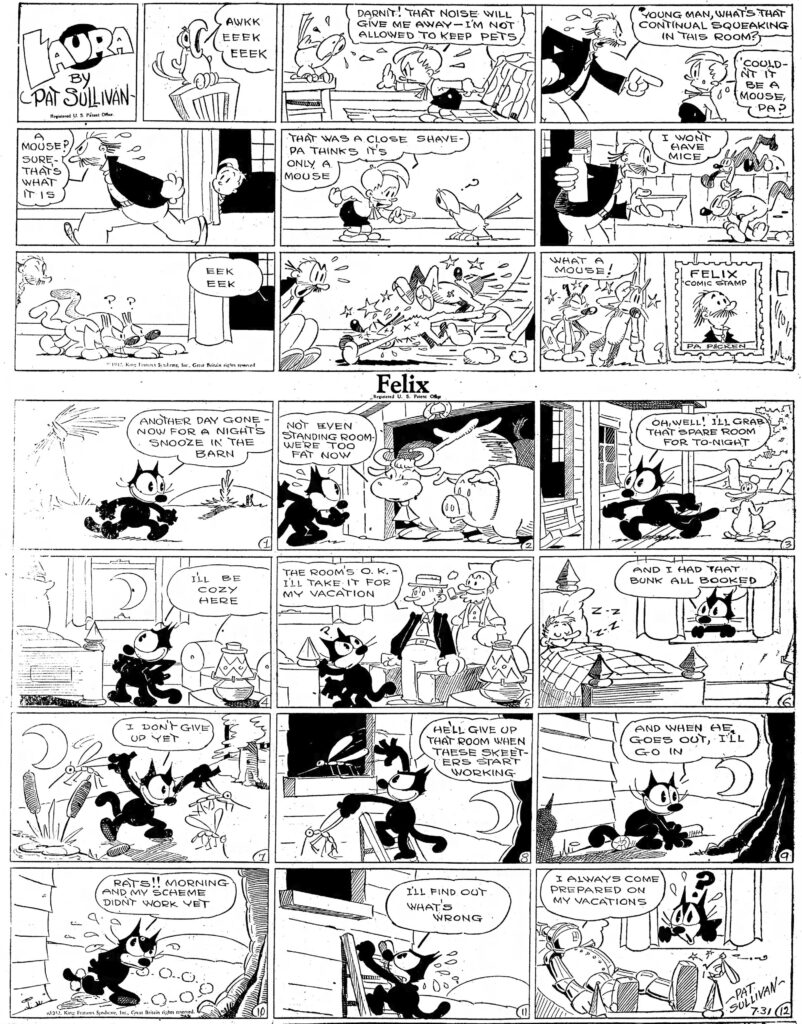
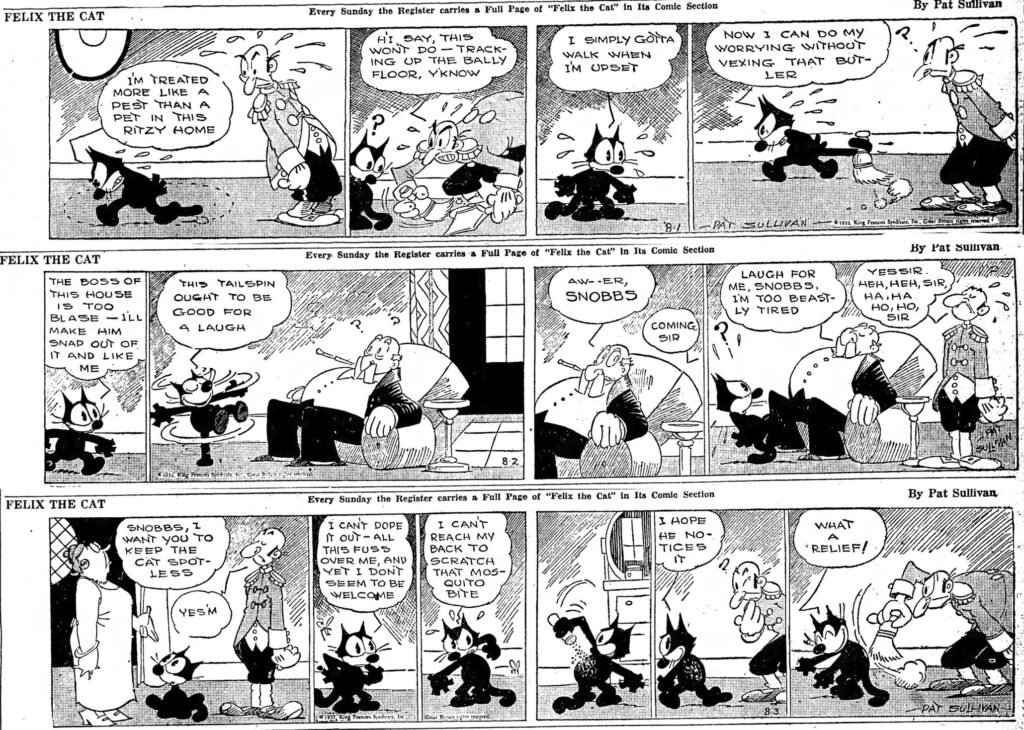
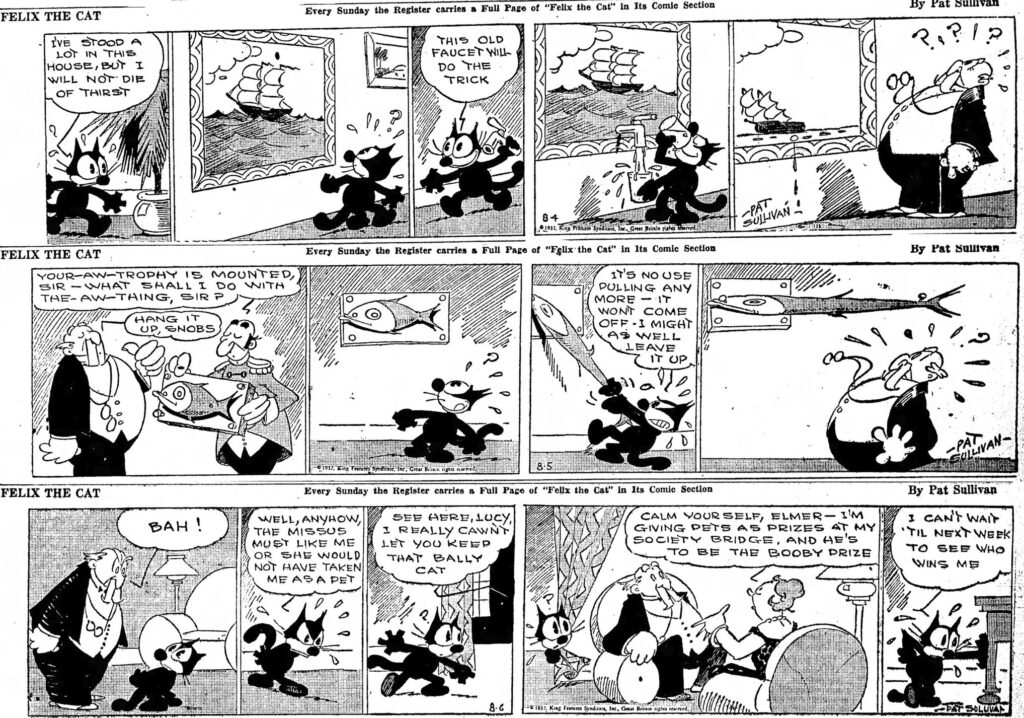
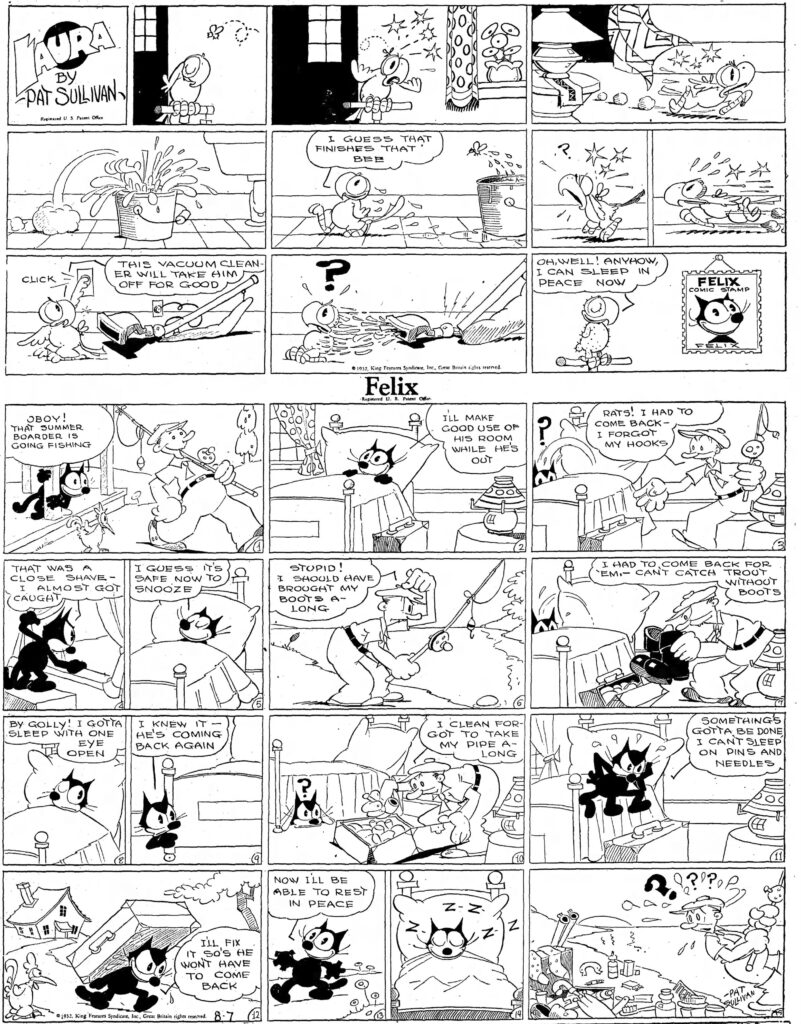
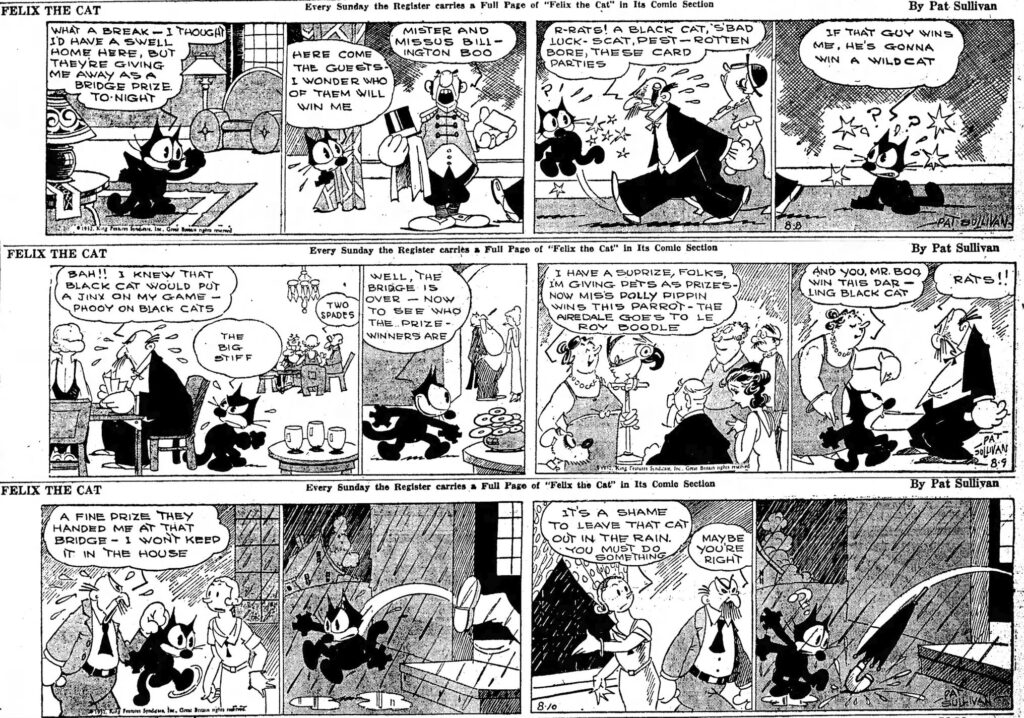
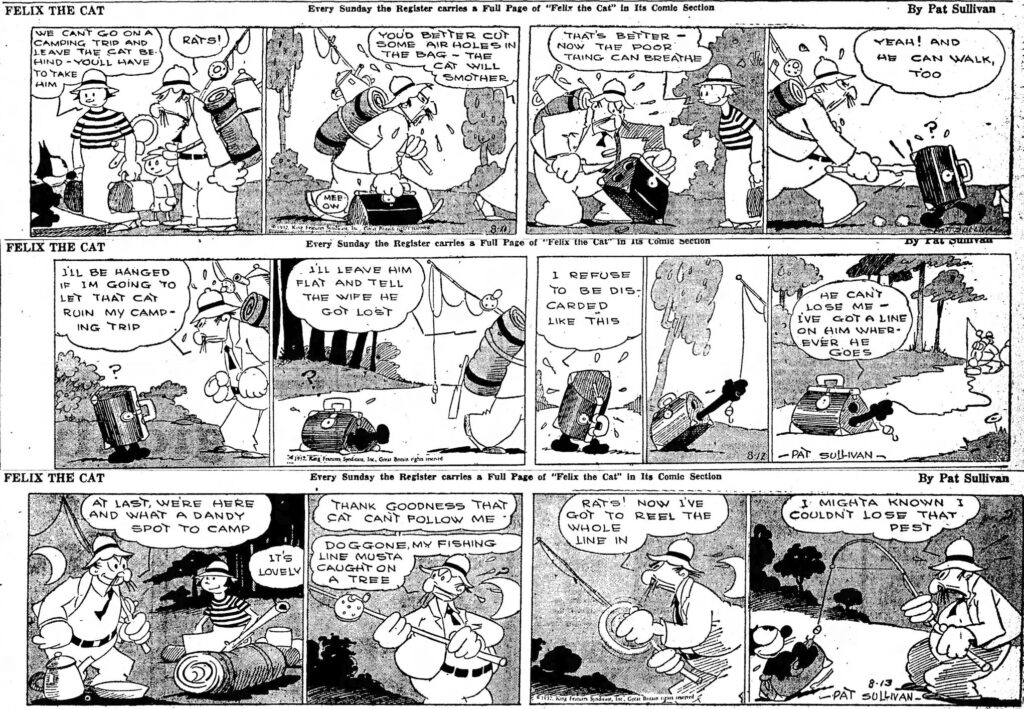
Hi Readers, Here are the Felix strips from 19320731 to 19320813. Felix is really passed around from rich family to rich family in these dailies. The 8-1, with a rare use of Felix’s trade-mark pacing walk (“I simply GOTTA WALK when I’m upset” declares the pedestrian puss) has Snobbs the butler tying a small whisk broom to Felix’s tale so that he cleans up his tracks as he paces. I also like the graphic gag in the 8-4, as Felix attaches a spigot to a painting of a ship at sea in order to get a drink. The rich couple give Felix away as a Bridge prize in the 8-9 to Mr. Billington Boo. Mr. Boo is convinced that black cats are bad luck, and shows complete contempt for Felix as a new house pet. Felix is tossed out of the Boos’ house in the rain, and then stuffed in a valise to accompany the Boos on a camping trip. Mrs. Boo suggests that Mr. Boo drill some holes in the valise, or “the cat will smother”. Felix gets no love from any of these aristocratic families. In the Sundays, Felix has his troubles with summer Boarders on the farm in the Sunday pages. He throws mosquitos on a sleeping boarder in the 7-31, then can’t sleep as the boarder keeps coming back to the guest room for fishing supplies in the 8-7. Enjoy these 1932 Felix strips, Folks, they have not been reprinted before. See you next time, Mark.
Felix is sold!



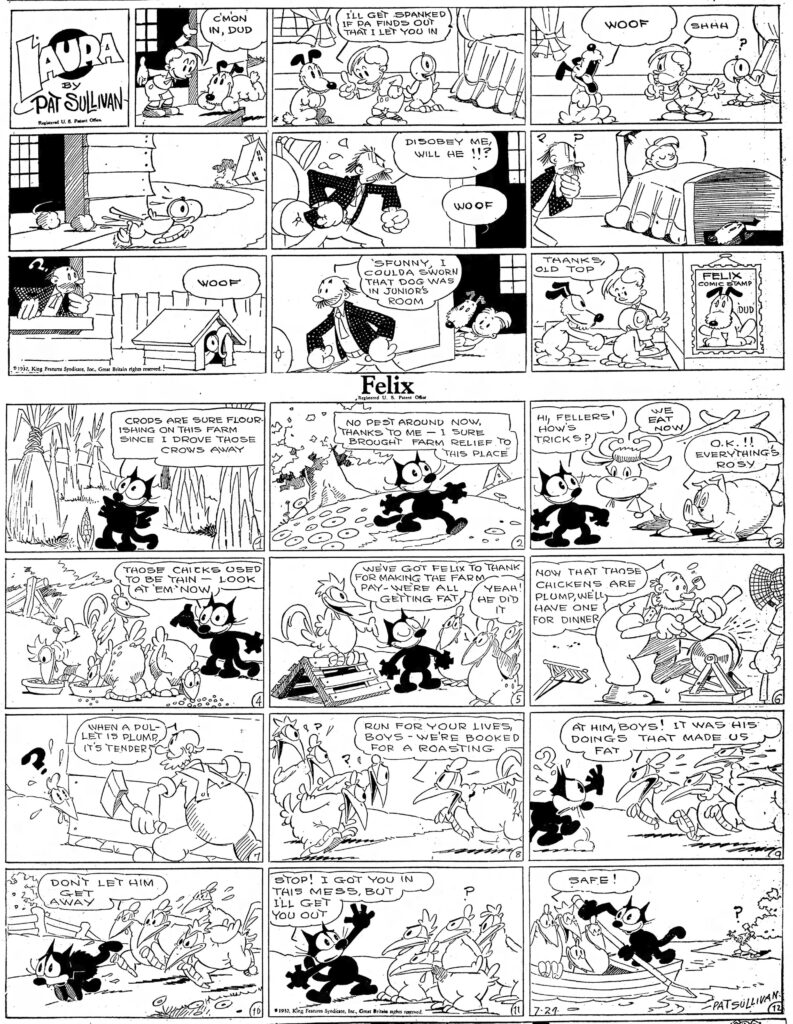
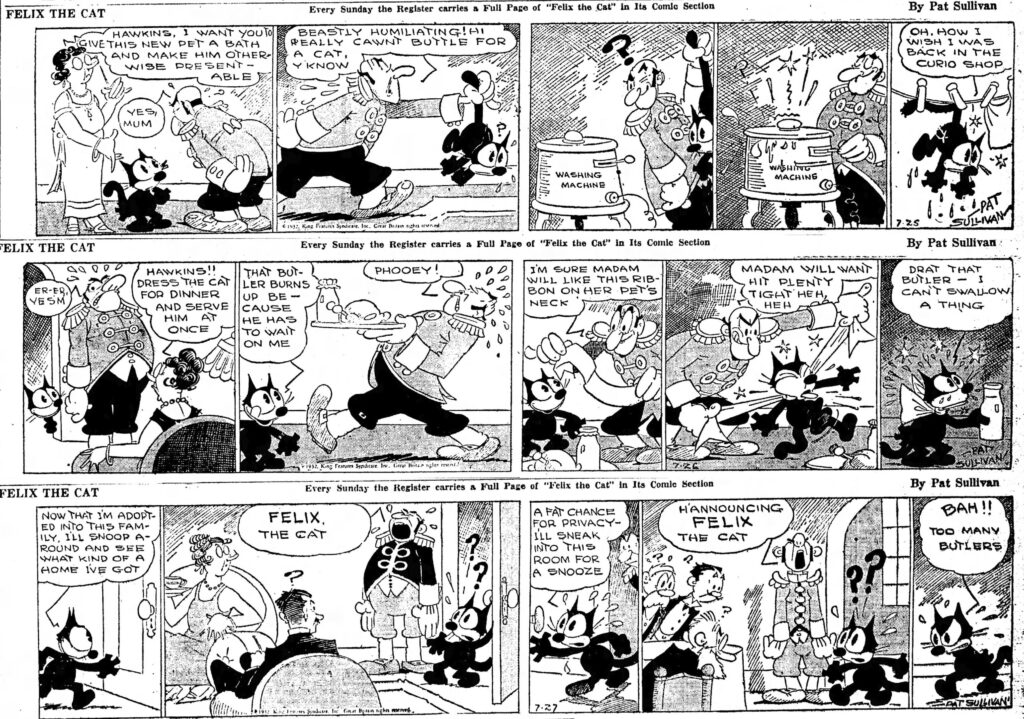

Hi Readers and fans of the 1932 Felix comic strips! Here are the Felix comics from 19320717 to 19320730! In the 7-22, Felix hits another milestone, the owner of the Curio Shop sells Felix to a well-to-do lady who is looking for a new house pet! The butlers will not buttle for a cat and the cook will not serve him any food! In the 7-29, the lord of the manor cuts expenses by not feeding Felix at all! Felix thinks up a brilliant scheme in the 7-30 and gets the key to the pantry full of goodies! In the Sundays, Felix is back on the farm! He tricks the crows away from the farm in the 7-17, and saves the plump and juicy chickens from the farmer’s roasting pan in the 7-24! I hope you enjoy more of Felix’s adventures from 1932, the best year of the Cat’s comics! Why all the exclamation points you ask?! It just looks more comical to me that way! Until the next time, Mark!
Felix Has CURIOS-ity






Hello again dear Readers, this time we have Felix from 19320703 to 19320716. In the Sundays, Felix finally returns from his long ocean voyage in the 19320710 page, but nearly goes on another voyage immediately! The dailies continue Felix’s attempts to please his new master, the proprietor of the Curio Shop. “Golf Widows” referred to in the 0707 and 0708 strips, were women who didn’t see much of their husbands because of the hubbies’s addiction to the sport of golf. I single out the 0713 as Felix tries to carry an invisible pane of glass that Kitty smashes with her purse, and the 0716 in which a new dog character is introduced named “Fibbo”. Fibbo sounds like a refugee from “Hawkshaw the Detective” by “Watso” (Gus Mager). I like Felix’s ingenuity in foiling Fibber’s fish story. Please continue to enjoy the best year of Felix, 1932! Comically, Mark
Felix Curio Shop Chuckles
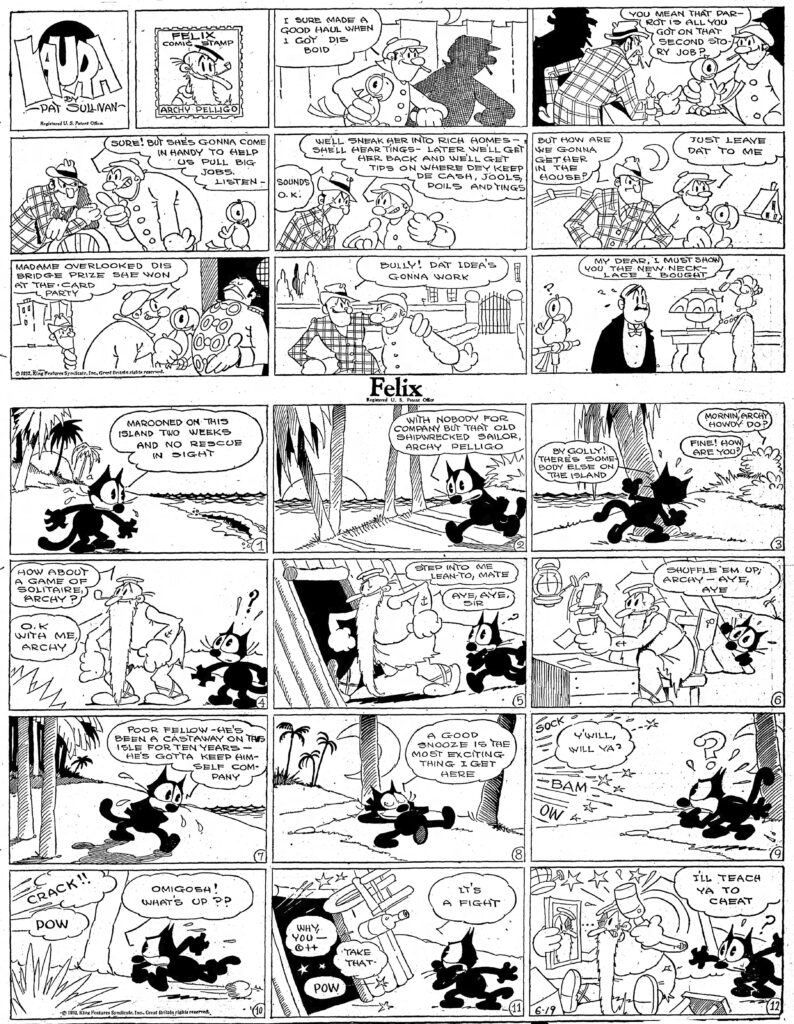
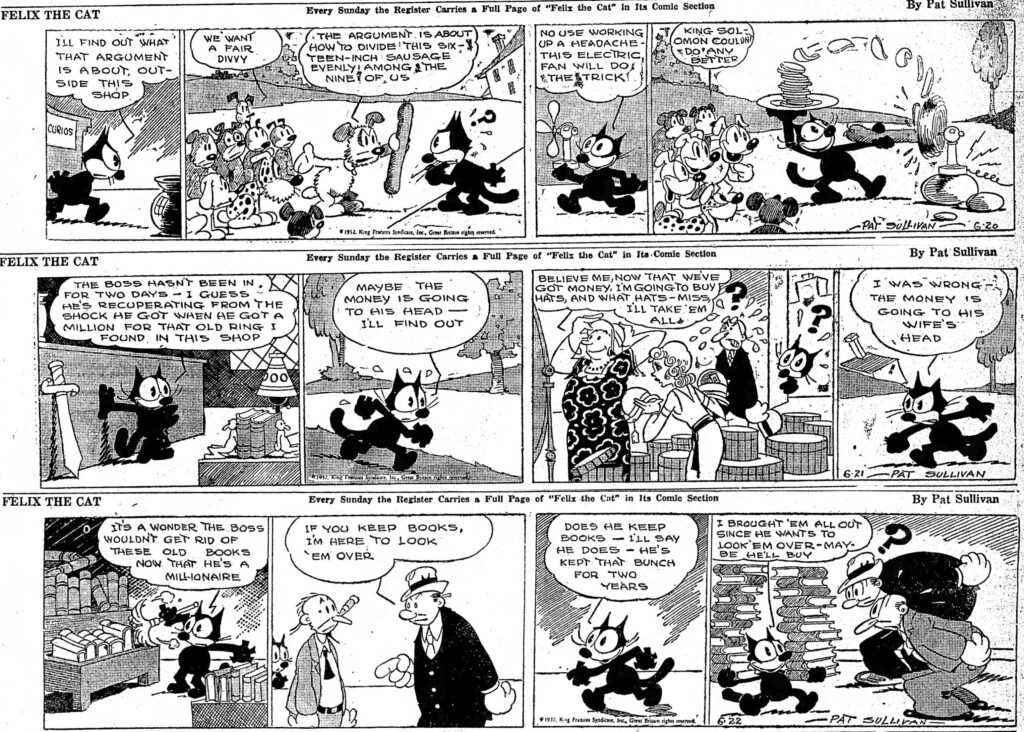
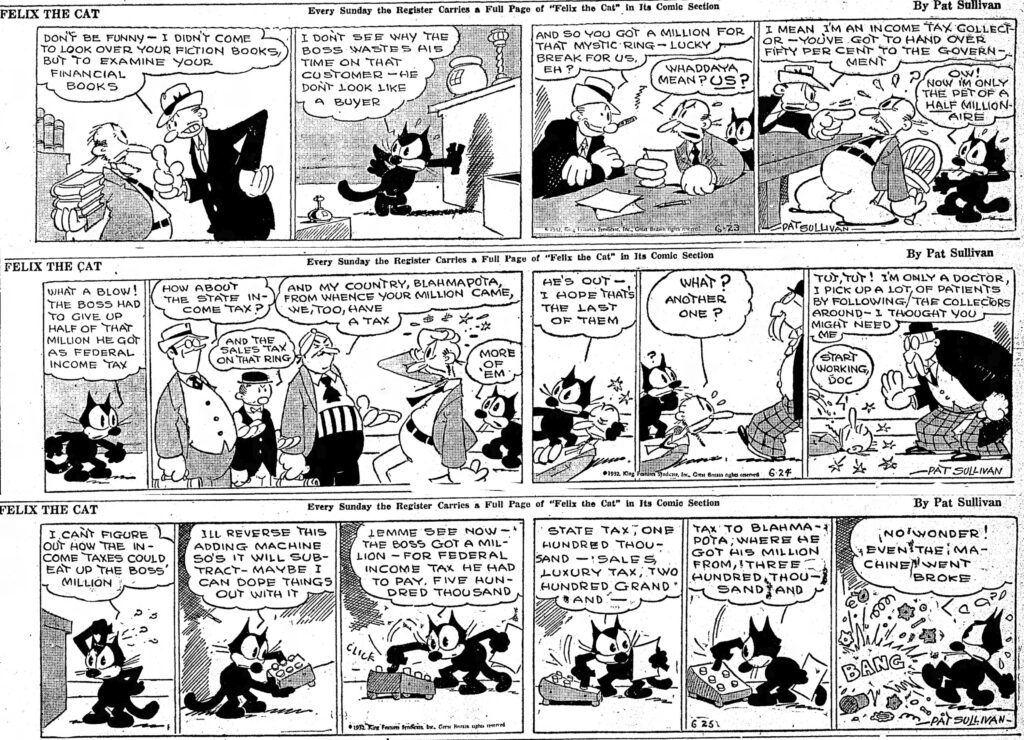
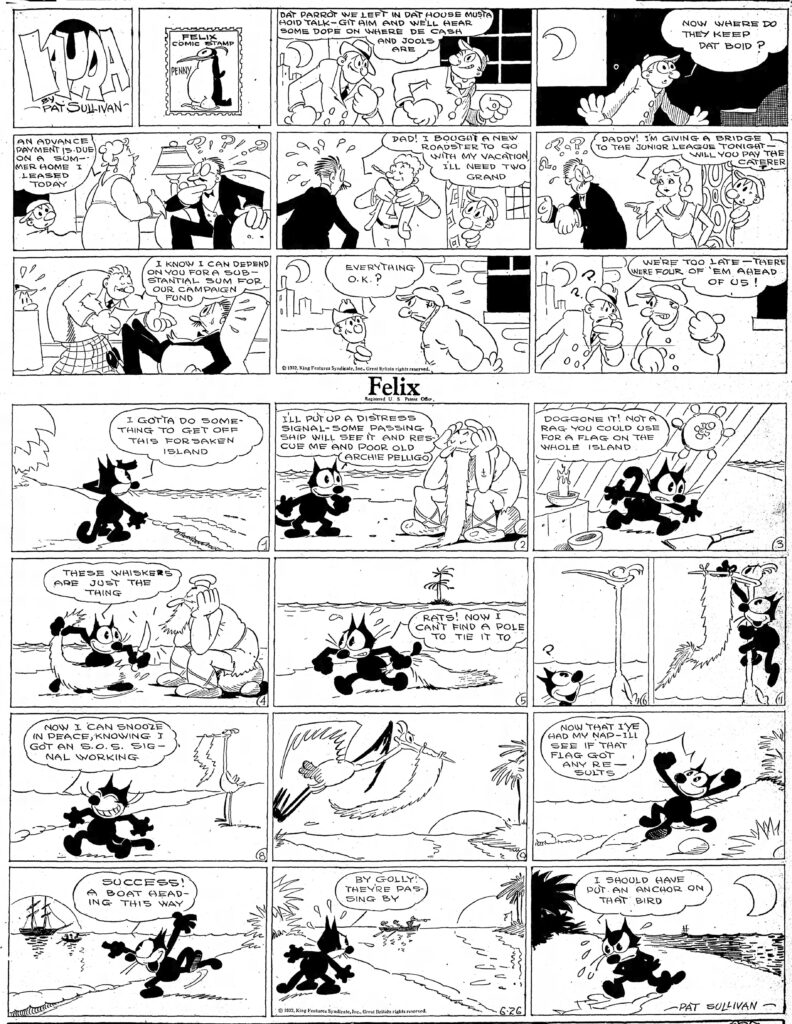
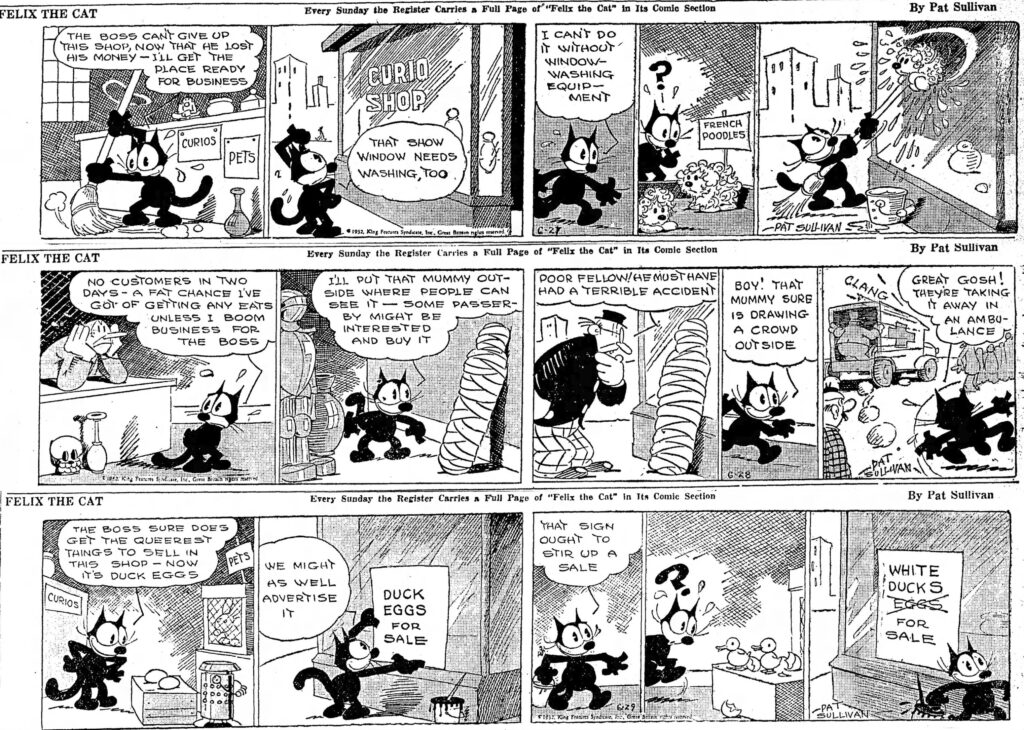
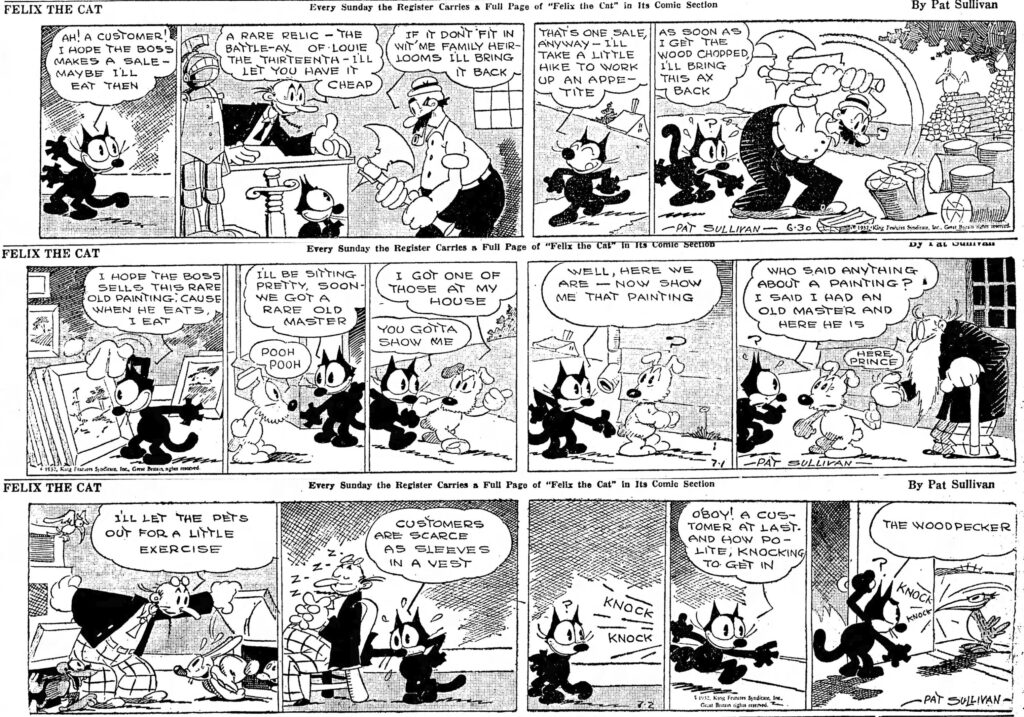
Happy Easter to my Catblog readers! Here’s Felix from 19320619 to 19320702. In the Sundays, Felix is shipwrecked on a desert island with sailor Archie Pelligo. In the dailies, Felix is still keeping house with the proprietor of the old Curio Shop. Felix tries to balance the books for his “Boss”, and washes the window with a French poodle in the 6/27, and in the 7/1, in the act of selling rare old paintings, meets a “rare old master”. Enjoy these terrific old comics, as usual drawn by the “rare old master”, Otto Messmer!
Felix Loses A Million Dollar Baby
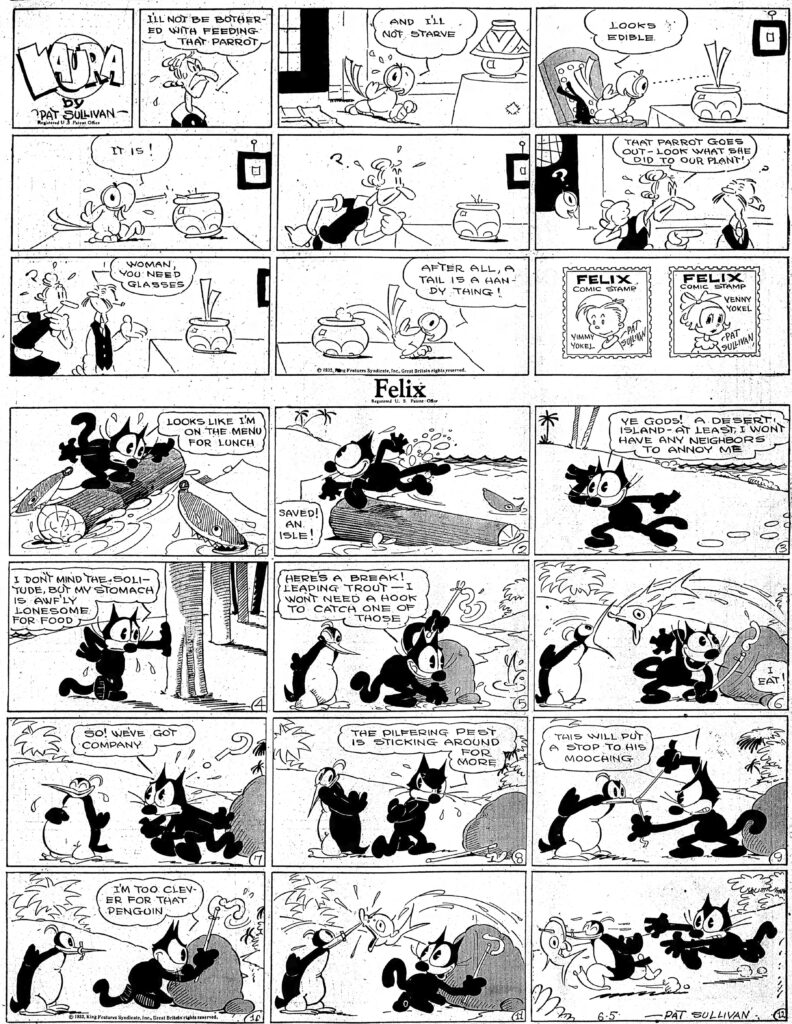
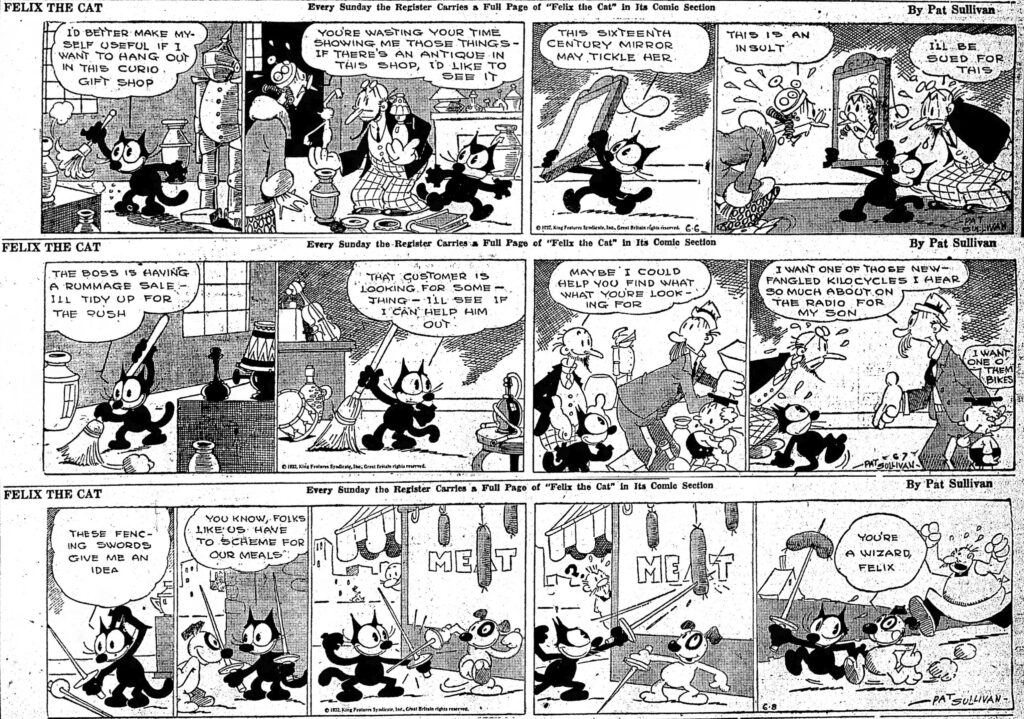
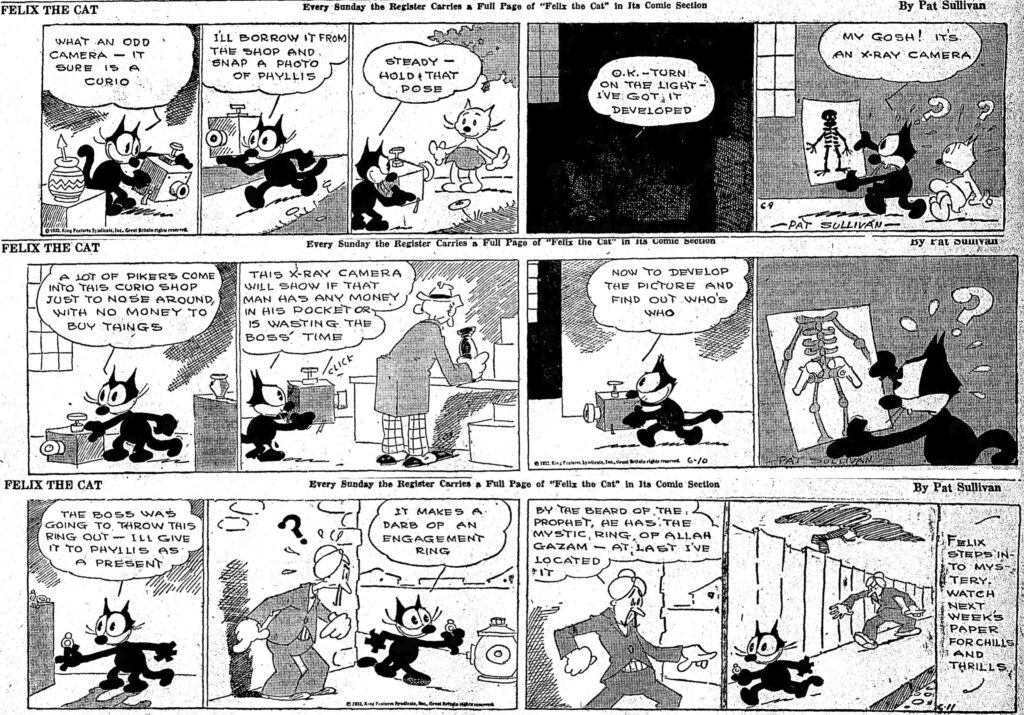
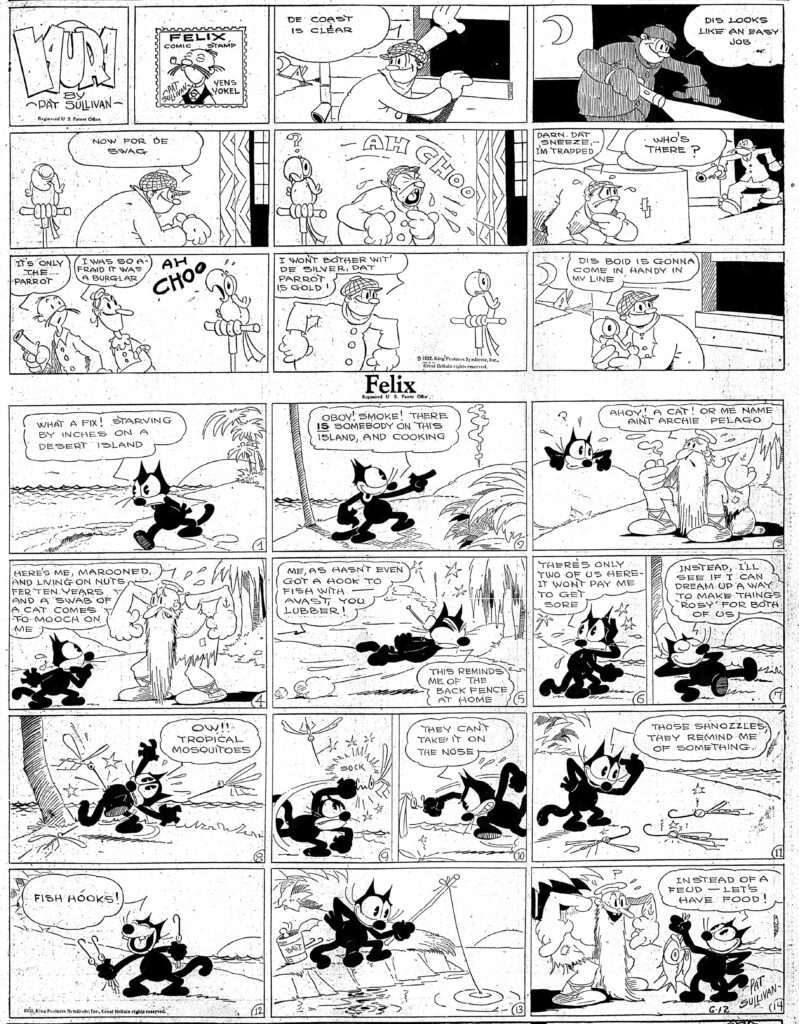

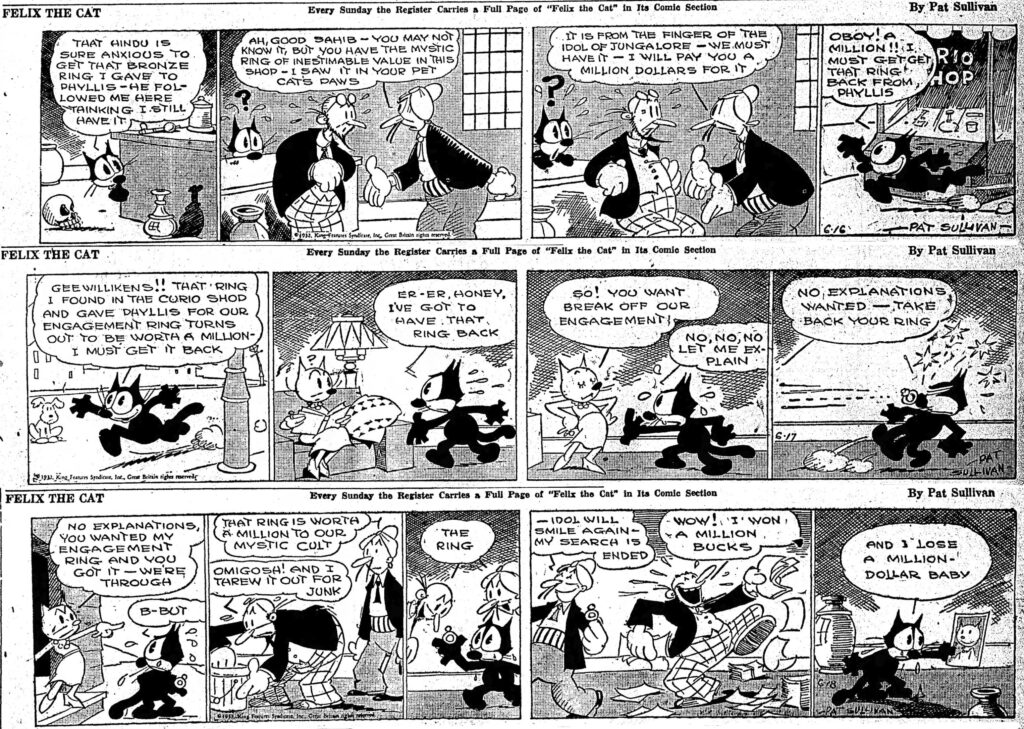
Here’s the next chapter of Felix from 1932, 19320605 to 19320618. Felix’s new home in the Curio Shop provides some scientific laughs as a Dad thinks that radio kilocycles are like bicycles to be ridden in the 6-7, and check out the Gags about X-Ray cameras in the 6-9 and 6-10. A quaint notion about X-Rays, yes? In the 6-11, the Magic Ring of Allah Gazam appears and opens a mysterious storyline. A Hindi seeks the ring (it is worth a great deal to his mystic cult) and has a million dollars to pay the owner of the Curio Shop if he will turn over the ring. Alas, Felix has given the Ring to his girl friend Phyllis, and has to pretend to break their engagement to get it back. Felix is very sad as he thinks he has lost his “Million Dollar Baby”, Phyllis. More to the story very soon. Thanks for reading Felix from 1932 on the Catblog!
Felix Homeless Again
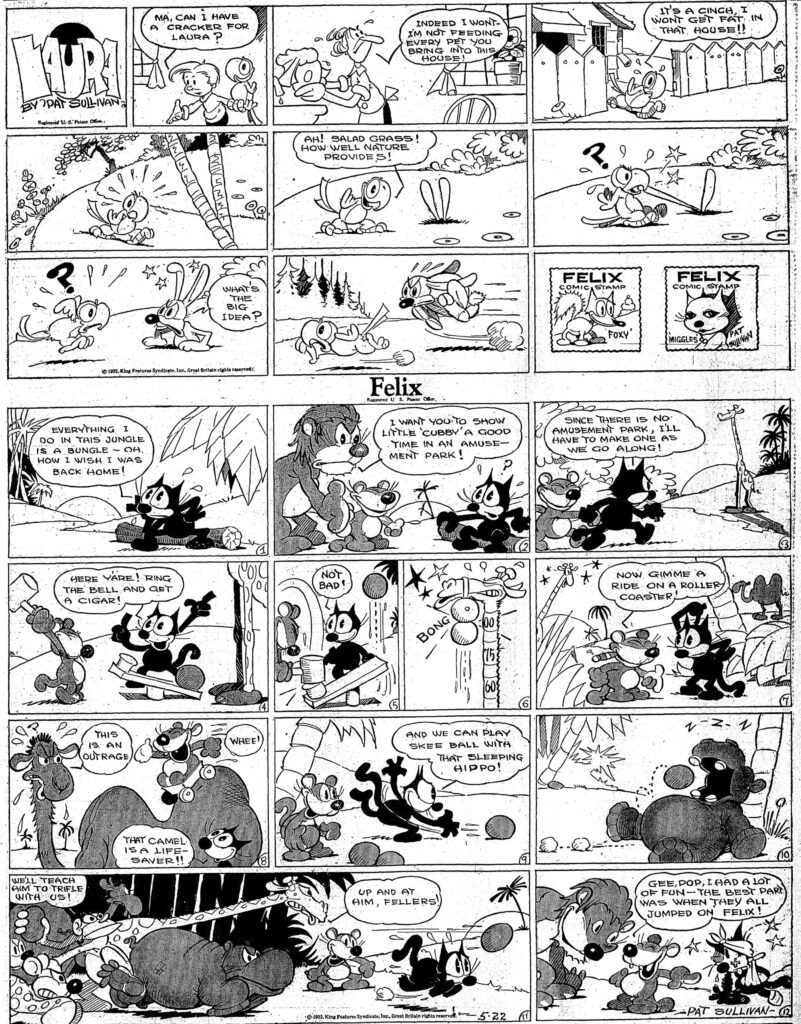
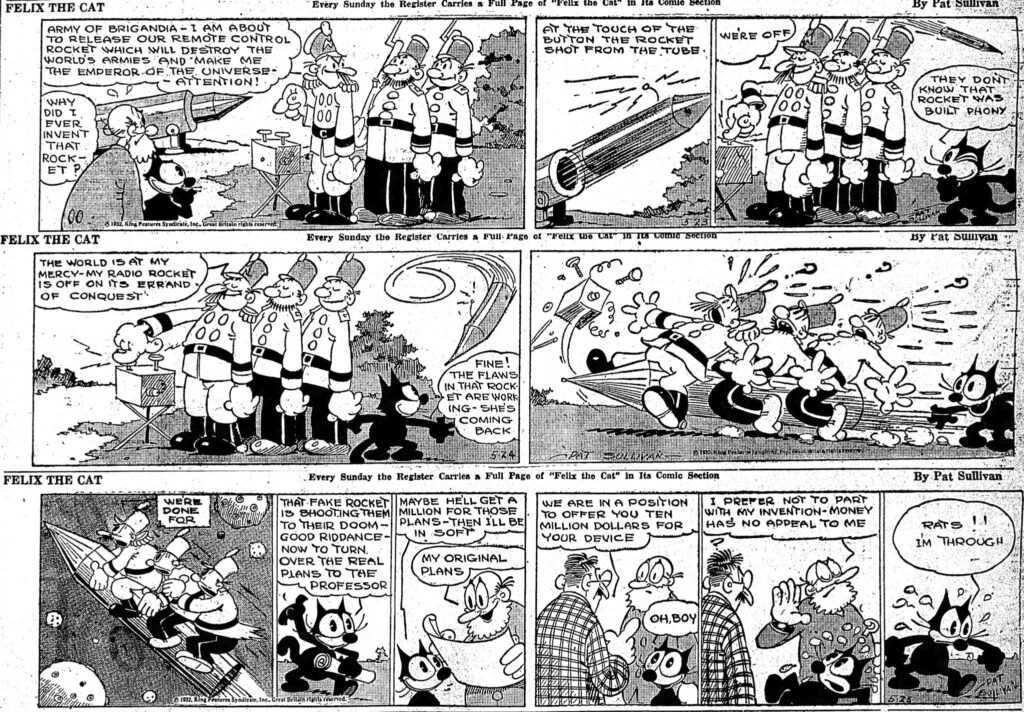
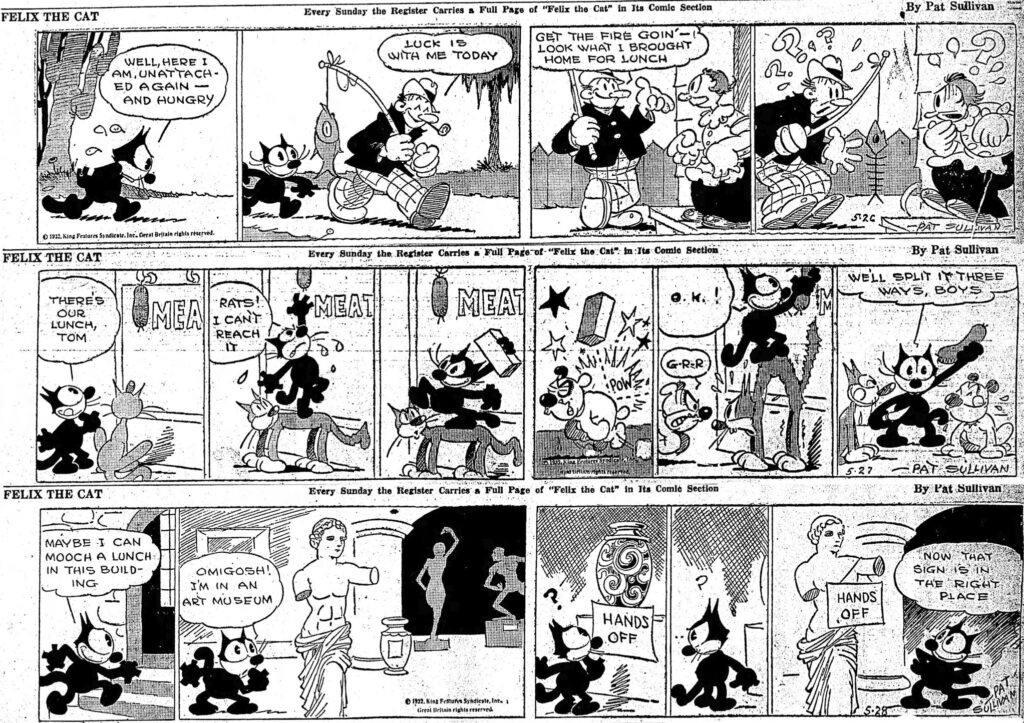
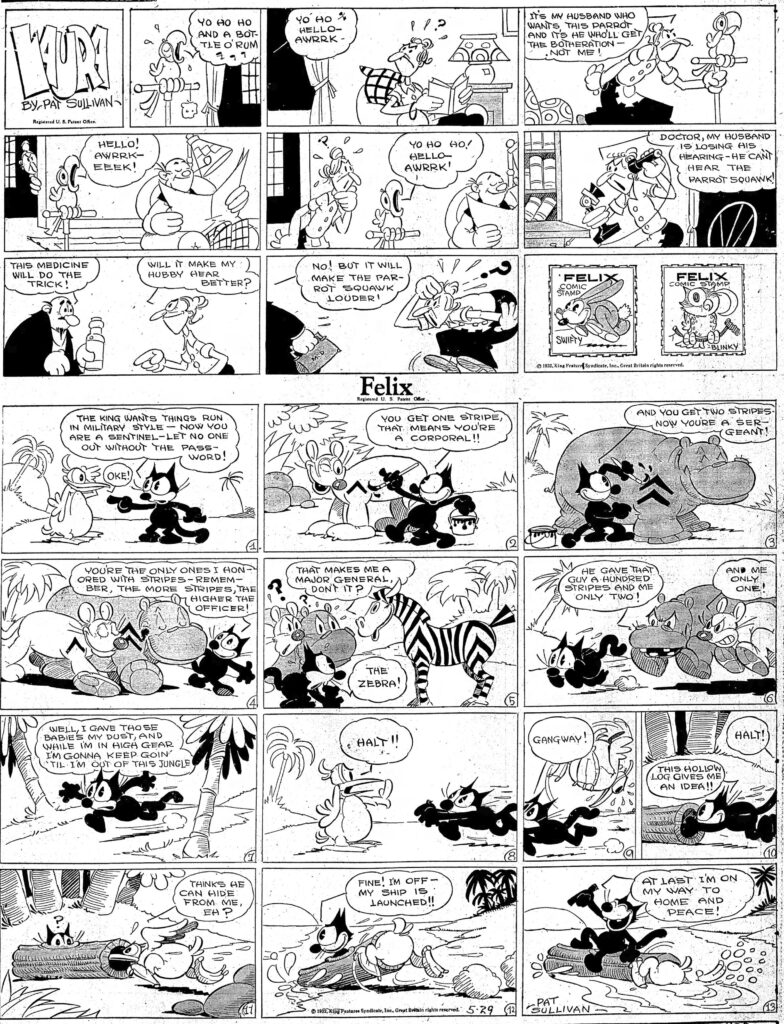
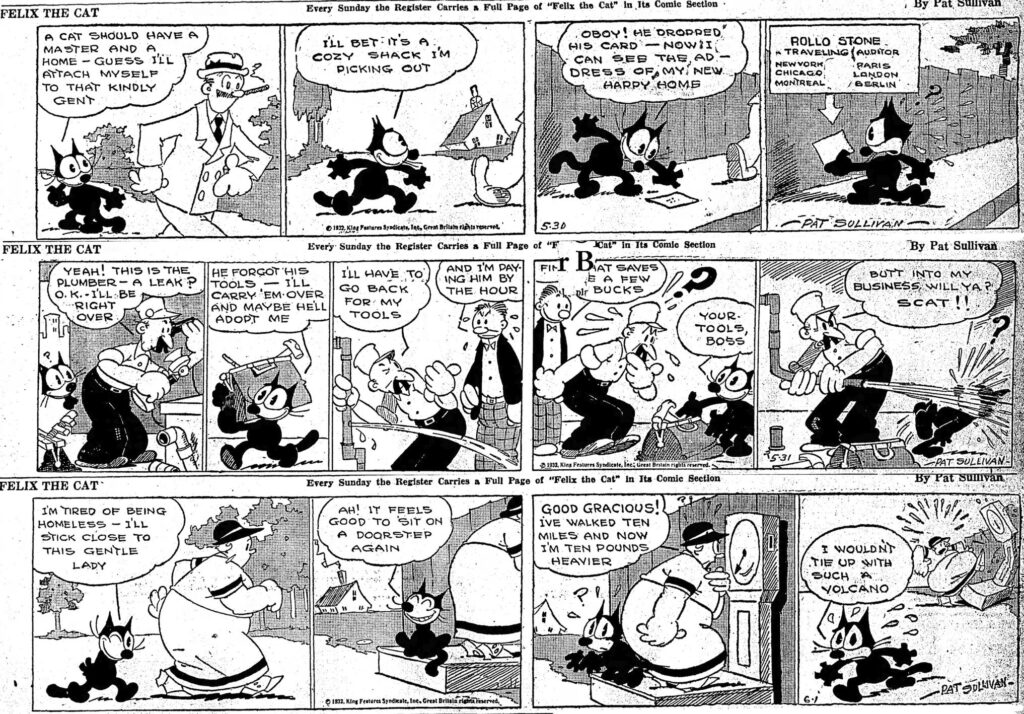
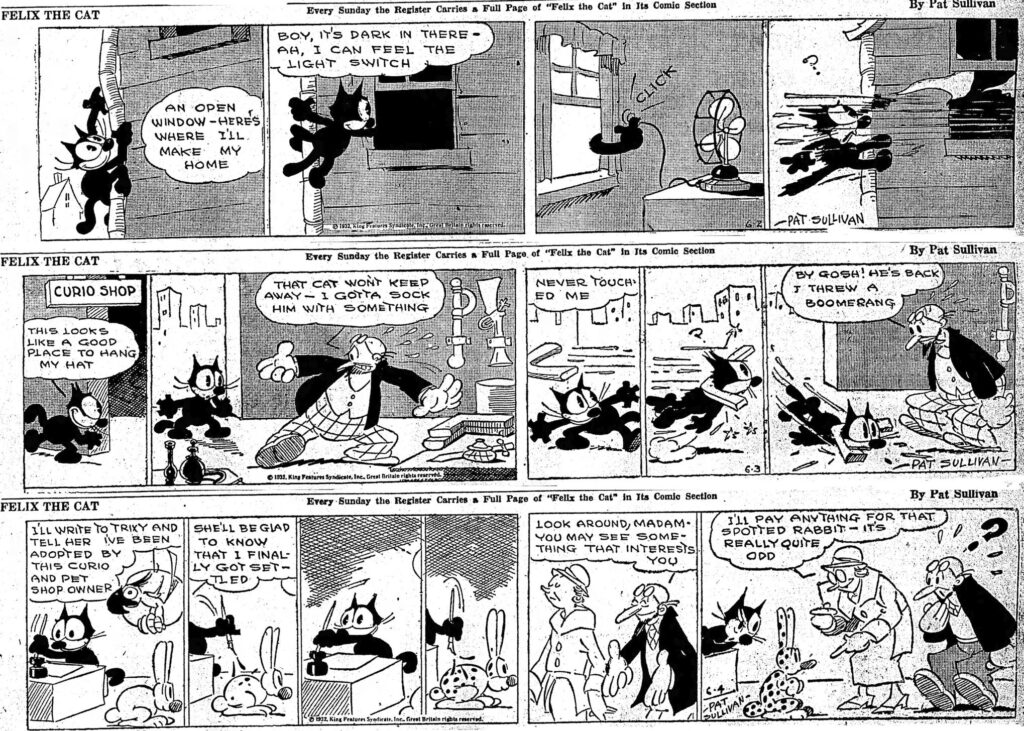
Hi Folks, Things are getting heavy, so I better update the blog with the next episode of Felix the Cat from 1932! Here are the strips from 19320522 to 19320604. Felix winds up his battle with the Army of Brigandia, with the Professor’s rocket attacking them and going haywire, thanks to Felix’s re-working of the capacitors in the rocket’s control panel. The Professor, being the idealist that he is, rejects a 10 million dollar offer for his rocket designs and once again Felix is homeless. After many attempts at finding a home, he holes up with a Curio and Pet Shop owner. Felix’s luck starts to work in the 6-4, as he uses a rabbit for a pen pad and the lady customer takes the lapin for a rare spotted variety. In the Comic Stamps featured in the Laura topper for the 5-29 Sunday, look at that “Blinky the Owl” stamp. It looks like Felix got cross-bred with an owl! I love that design. Sorry I’m so far behind on the Catblog posts, I’ll try harder. See you very soon, I’m hopeful. Mark
Mabel Can Only Be A Sister To Jimmy
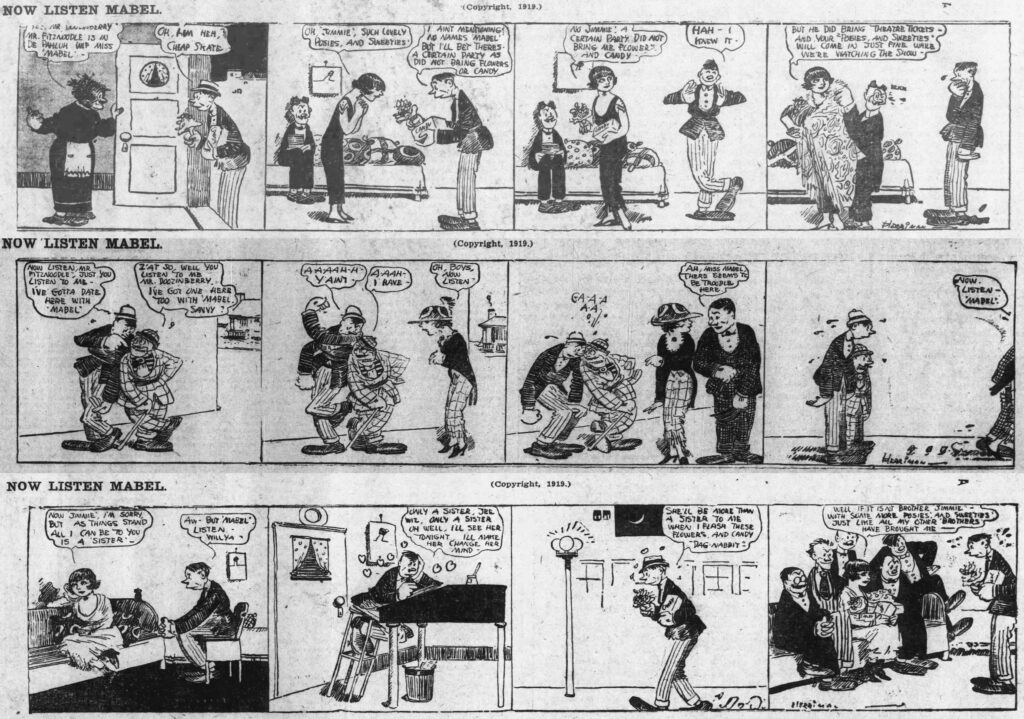
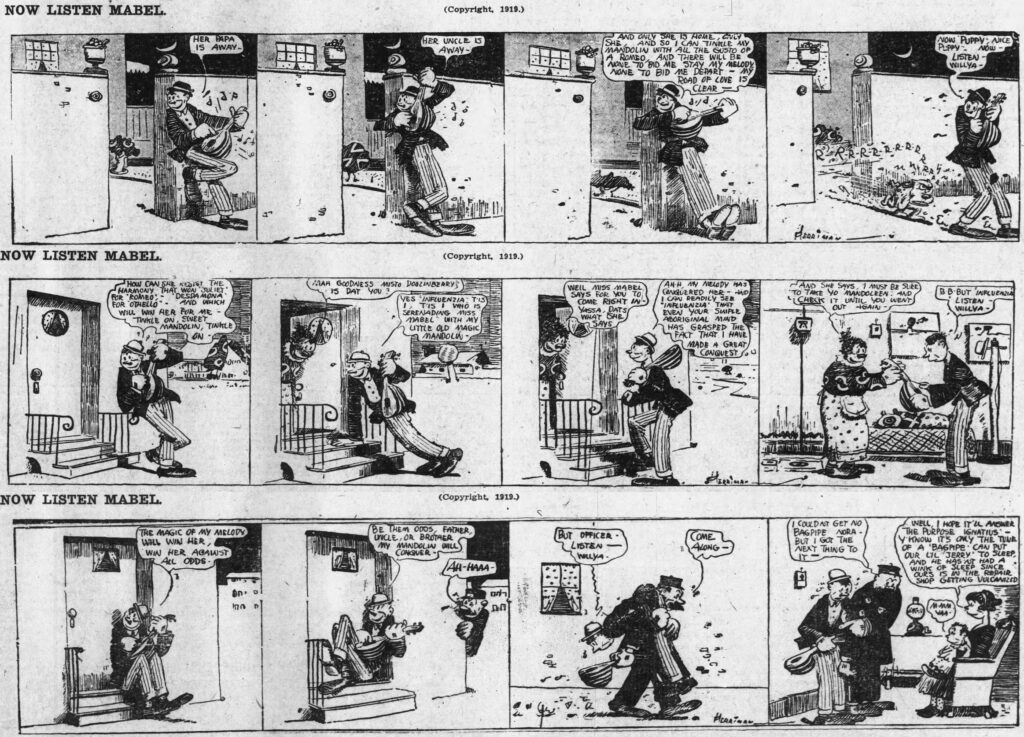
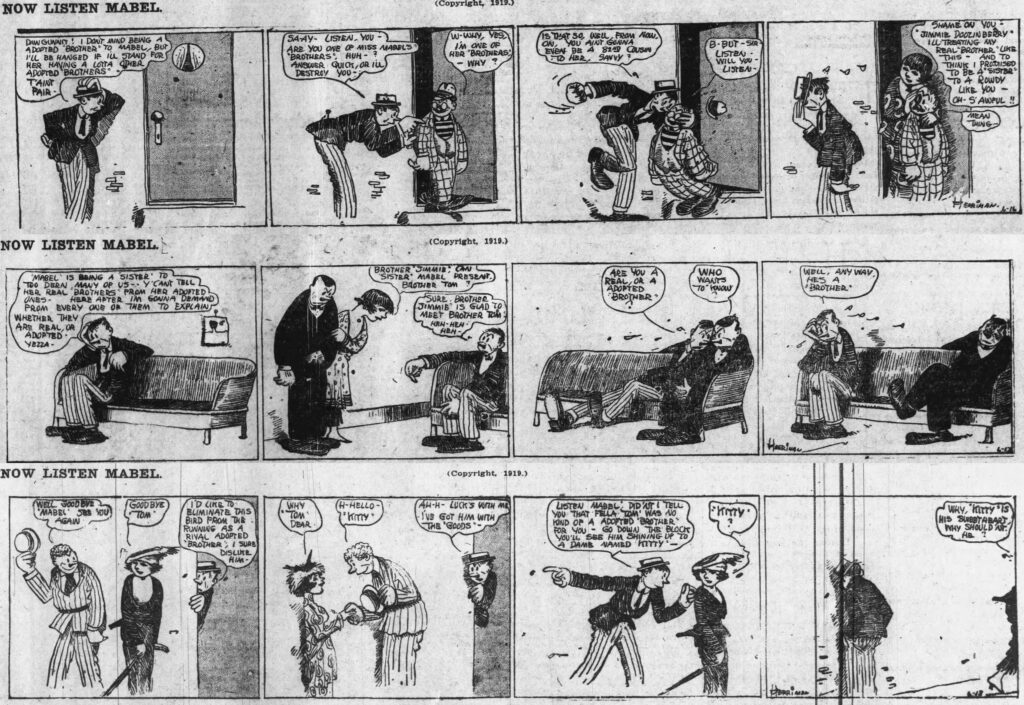
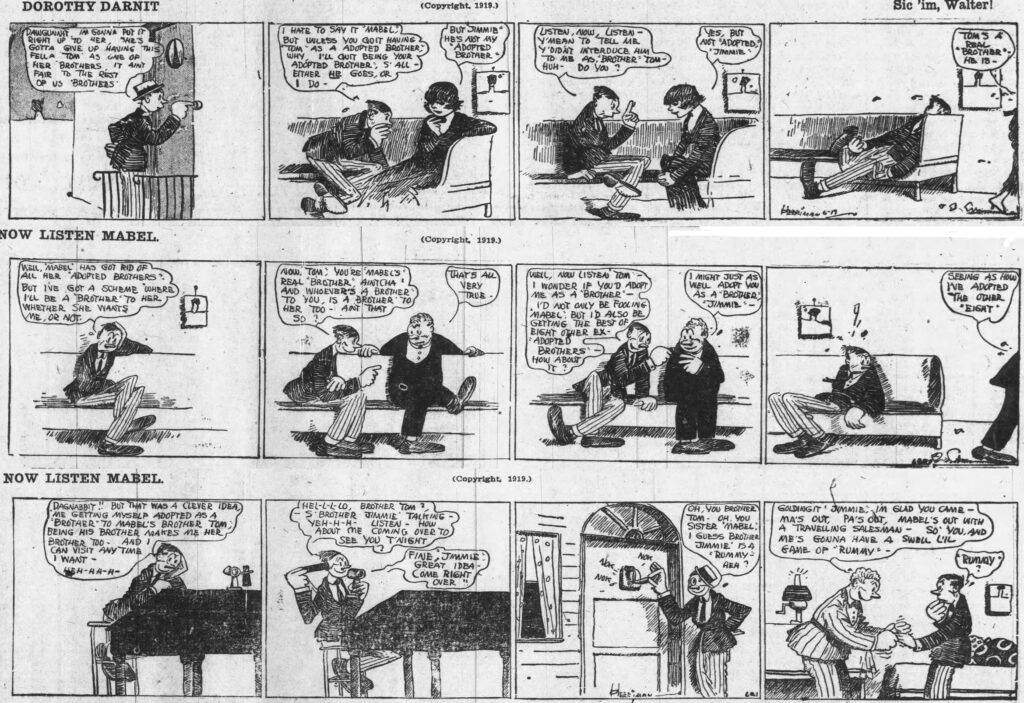
Here, dear readers, is the return of George Herriman’s “Now Listen, Mabel” from 6-9 to 6-21-1919. The strip started April 23, 1919 according to comic strips historian Allan Holtz. A good friend has found some of the earlier episodes of Mabel and is sharing them with us. In the 6-10 strip, the phrase “Now Listen, Mabel” is uttered by a handsome stranger who takes Mabel away from Jimmie and his rival. There might be more such uses of the strip’s catchphrase if we ever find the first month and a half or so of Mabel. Jimmie Doozinberry, as in the rest of the Mabel dailies, is constantly frustrated by Mabel’s seeking safety in numbers and relentlessly playing the field with many rivals for Jimmie’s affections. Mabel just wants to be a “sister” to Jimmie and a parade of other men. Jimmie in desperation talks Mabel’s brother Tom in to adopting him as his brother, thereby becoming a brother to Mabel as well with full visitation rights. We’ll see how that turns out in time. If you seek out the post, “An End and A Beginning”, you can see the earliest “Now Listen, Mabel” dailies published by the San Francisco Examiner, starting 7-28-1919. The Catblog will try to fill in the gap in Mabels from 6-23 to 7-26-1919 very soon. A Happy New Year to you all.
Felix Fakes the Rocket Plans and Happy Holidays!
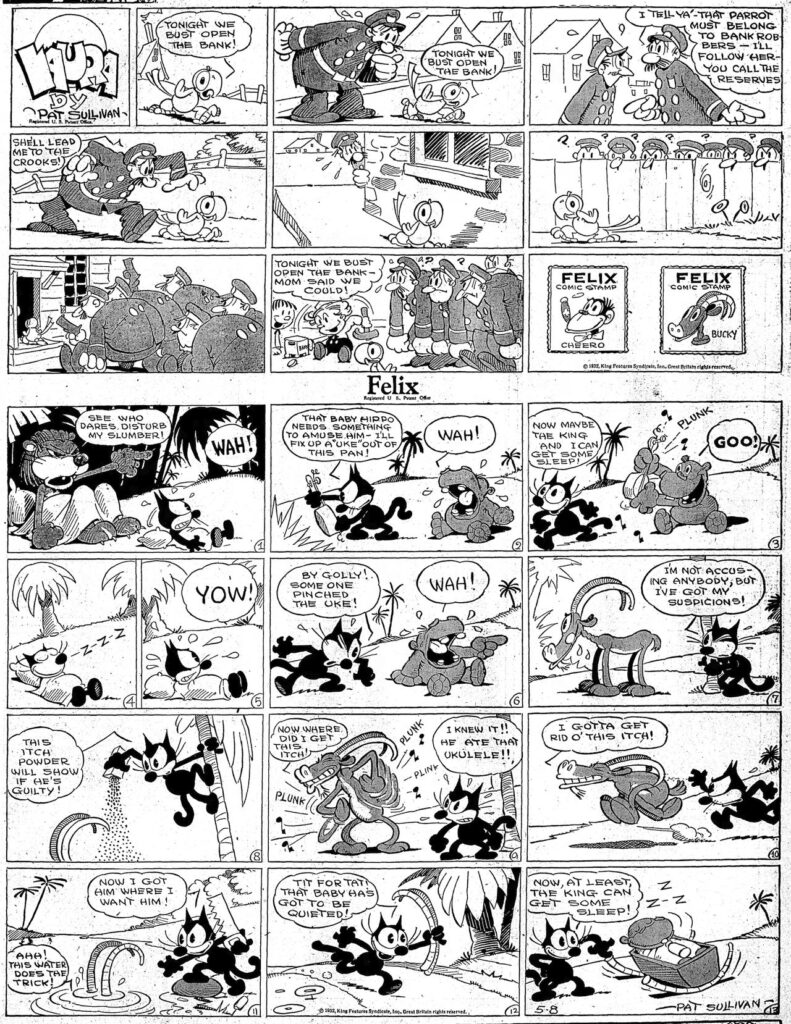
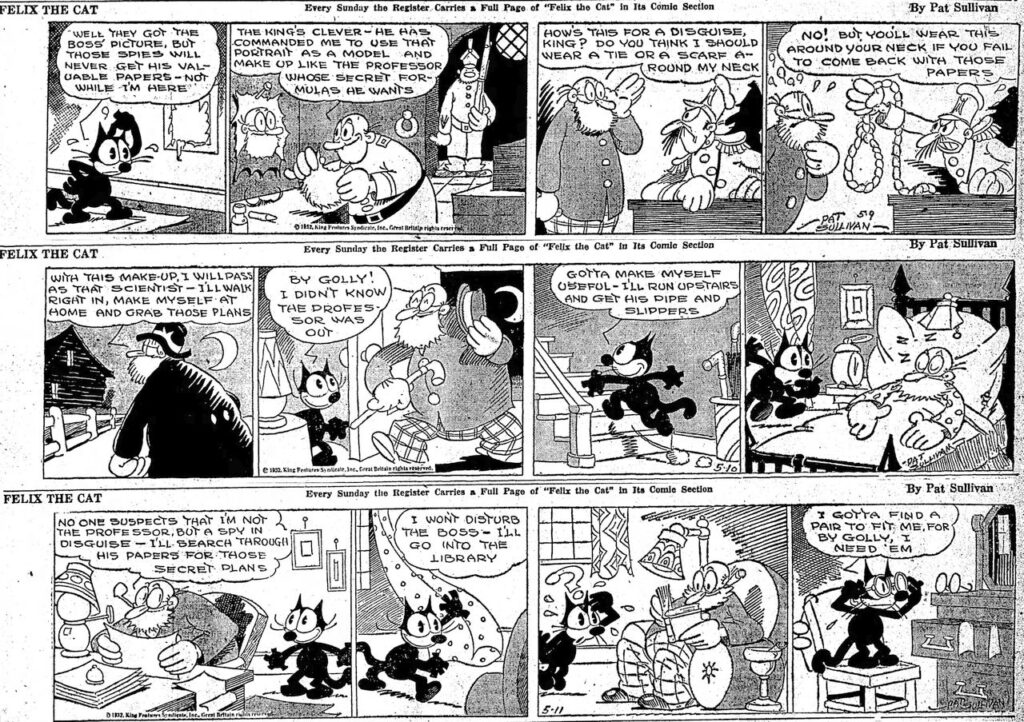
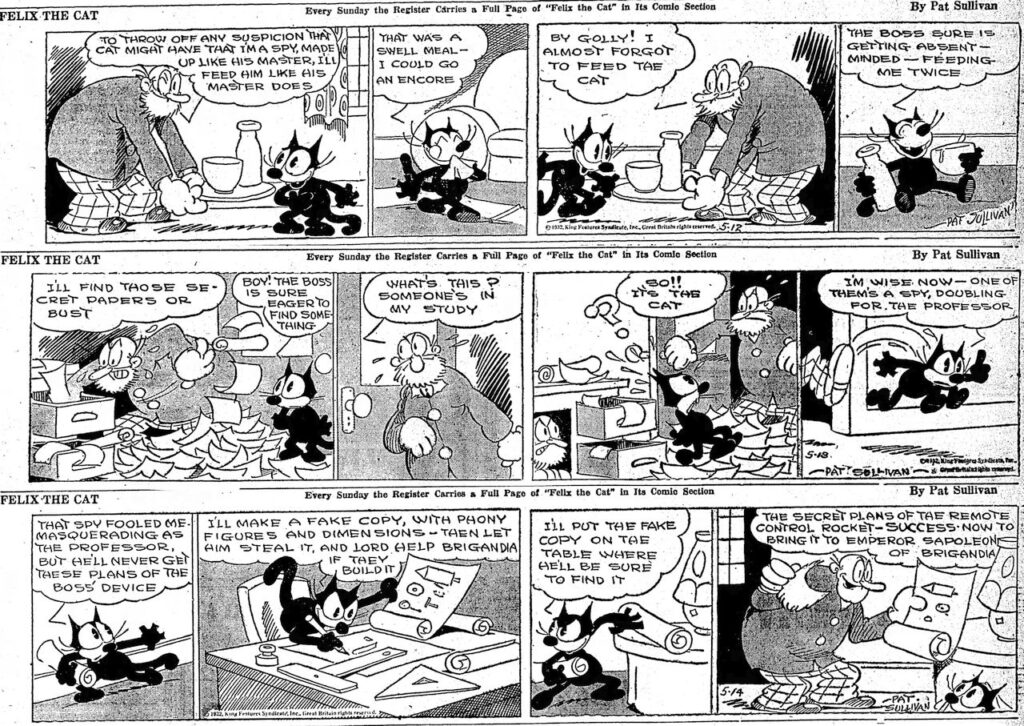
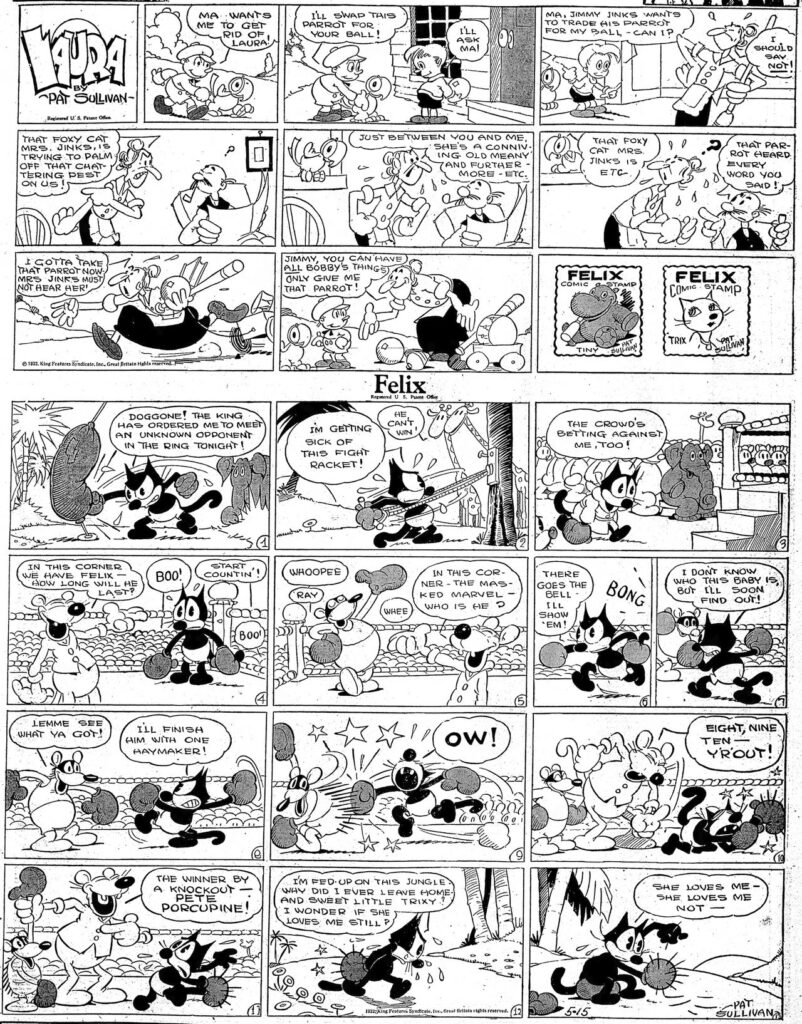
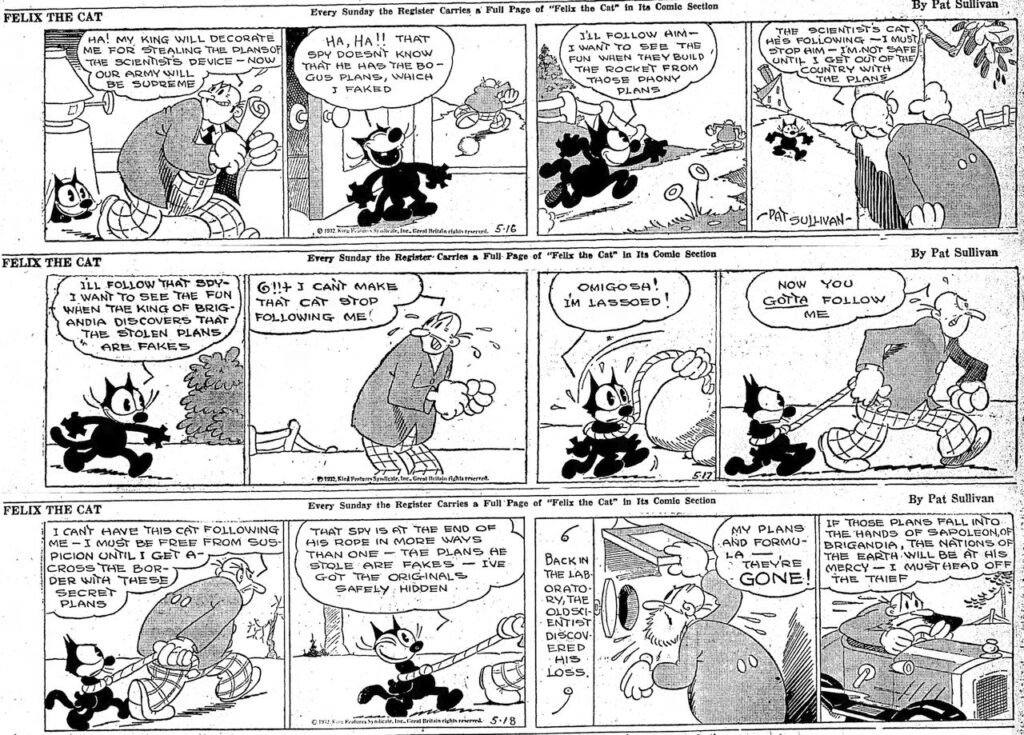
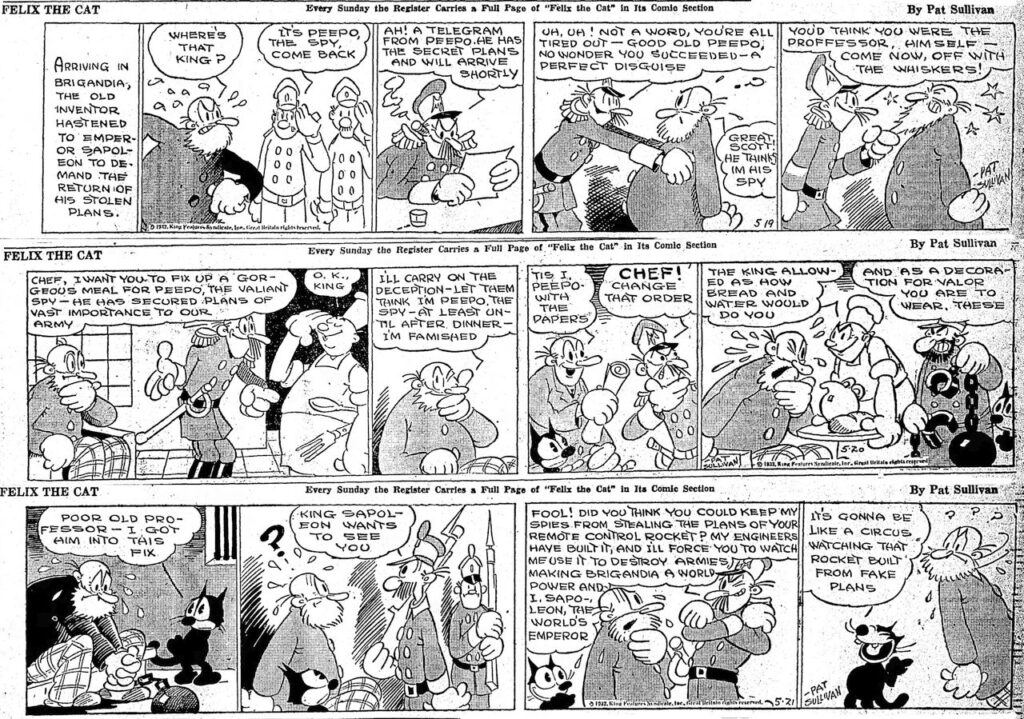
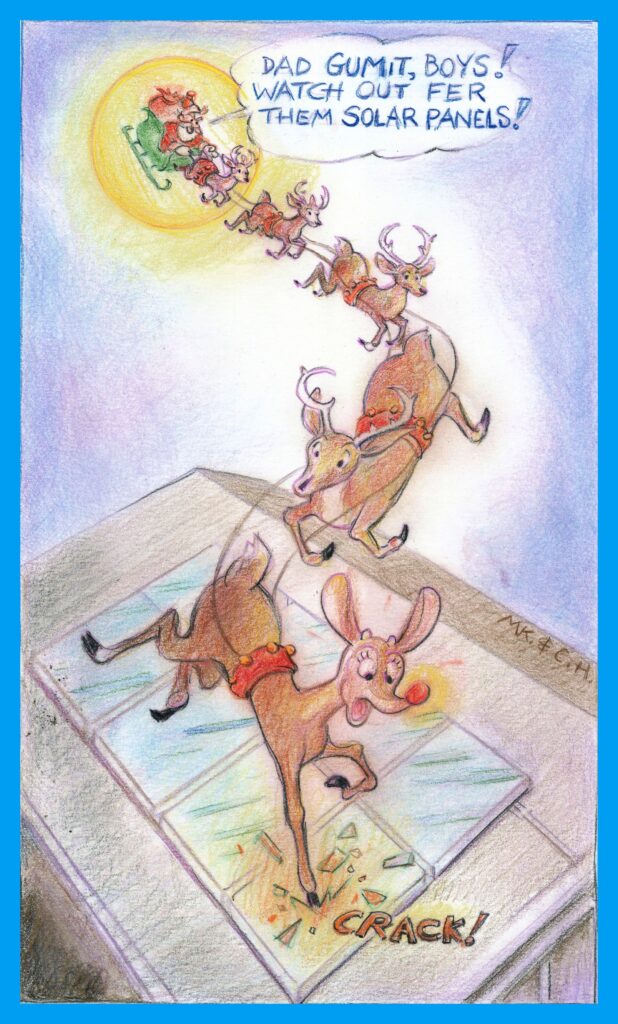
Hi Folks, Here are the Felix strips from 19320508 to 19320521 with the next chapter of the Spy story. Felix ingeniously fakes the rocket plans and slips them to the spy masquerading as the Professor. Also I’ve included our Happy Holidays card from my wife Cathy and myself. She worked out the color with Prismacolor pencils, and I did the layout and Gag. It’s a tribute in a way to Rube Grossman, a Fleischer animator who drew Rudolf for D.C. Comics in 1950. Happy Holidays to all my readers!
So Long Mabel
![]()
![]()
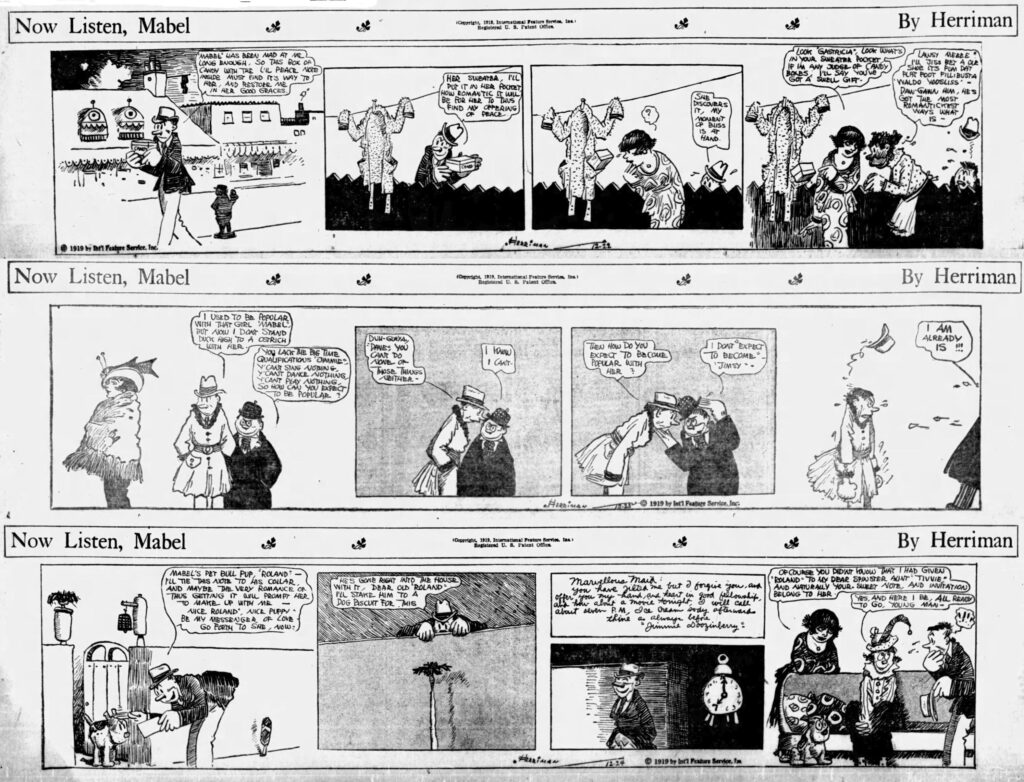
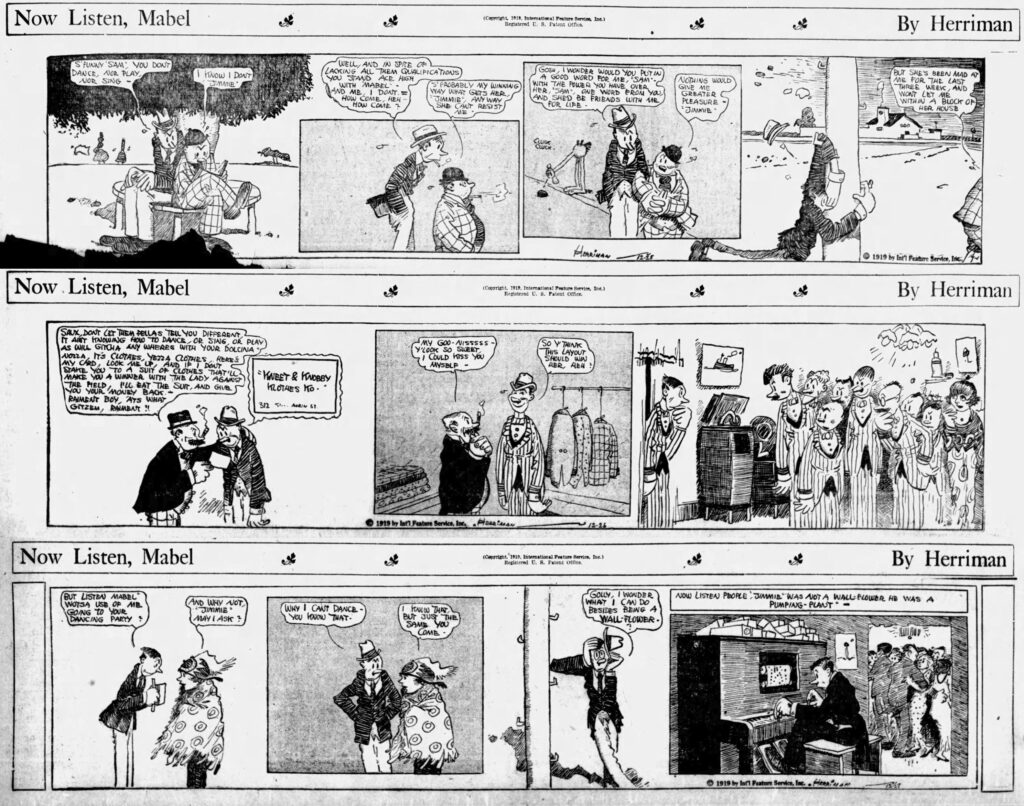
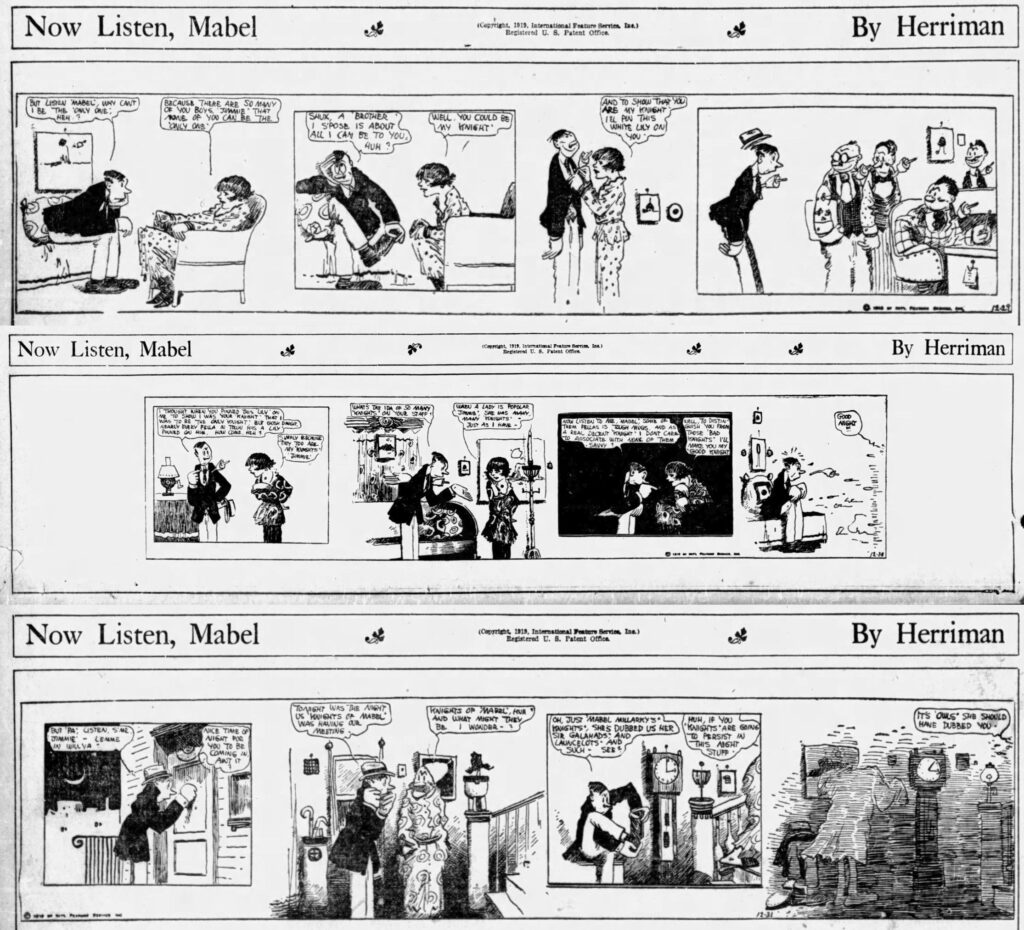
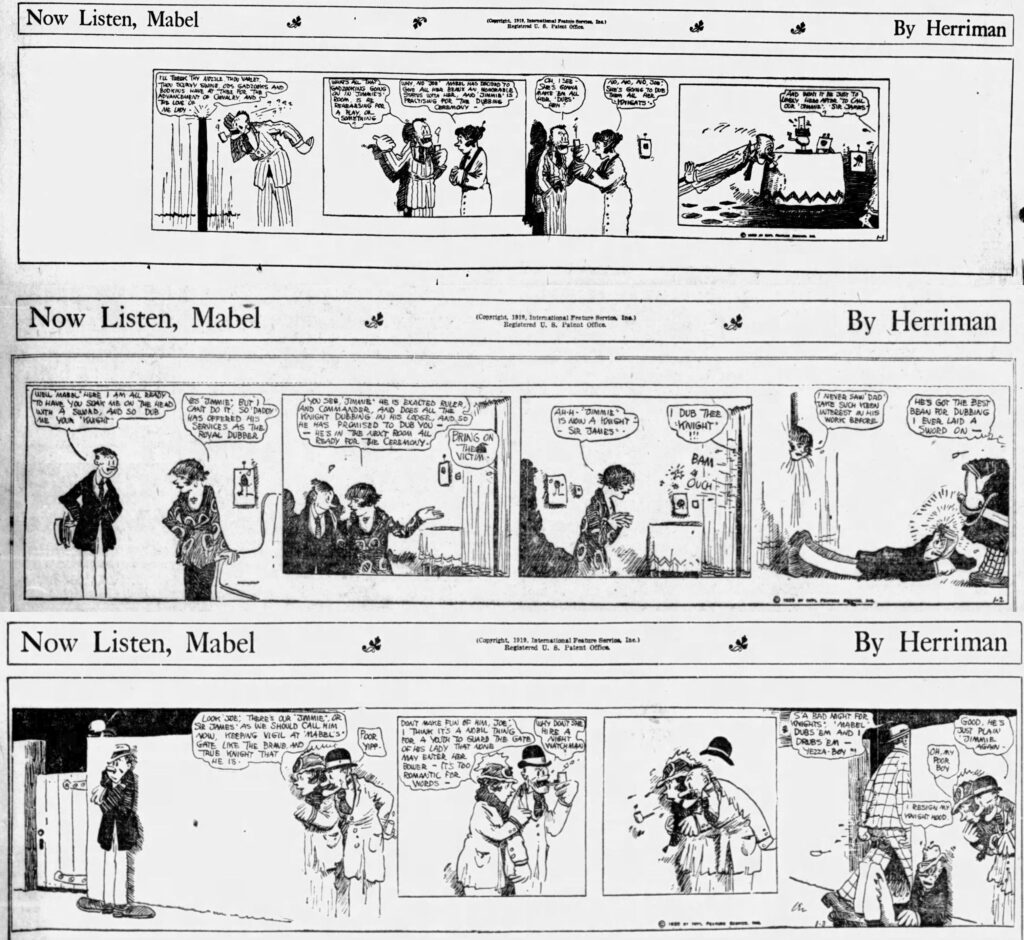
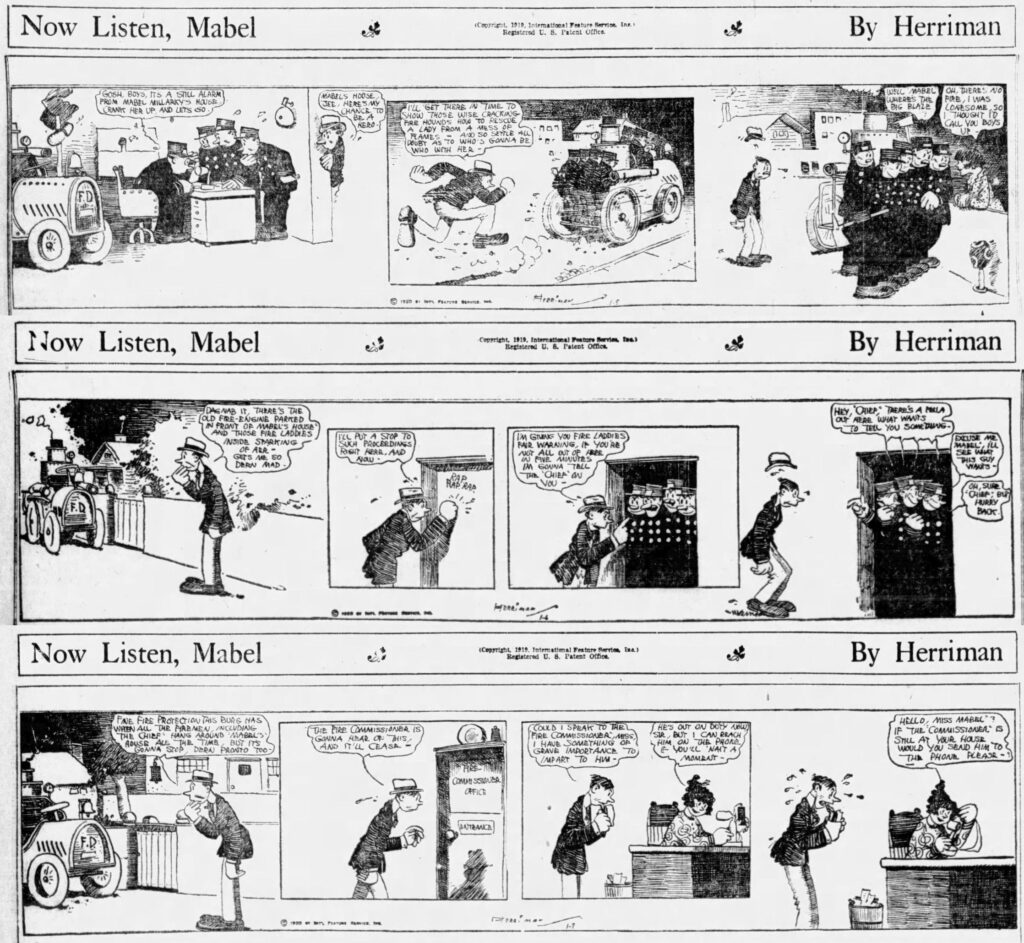
H
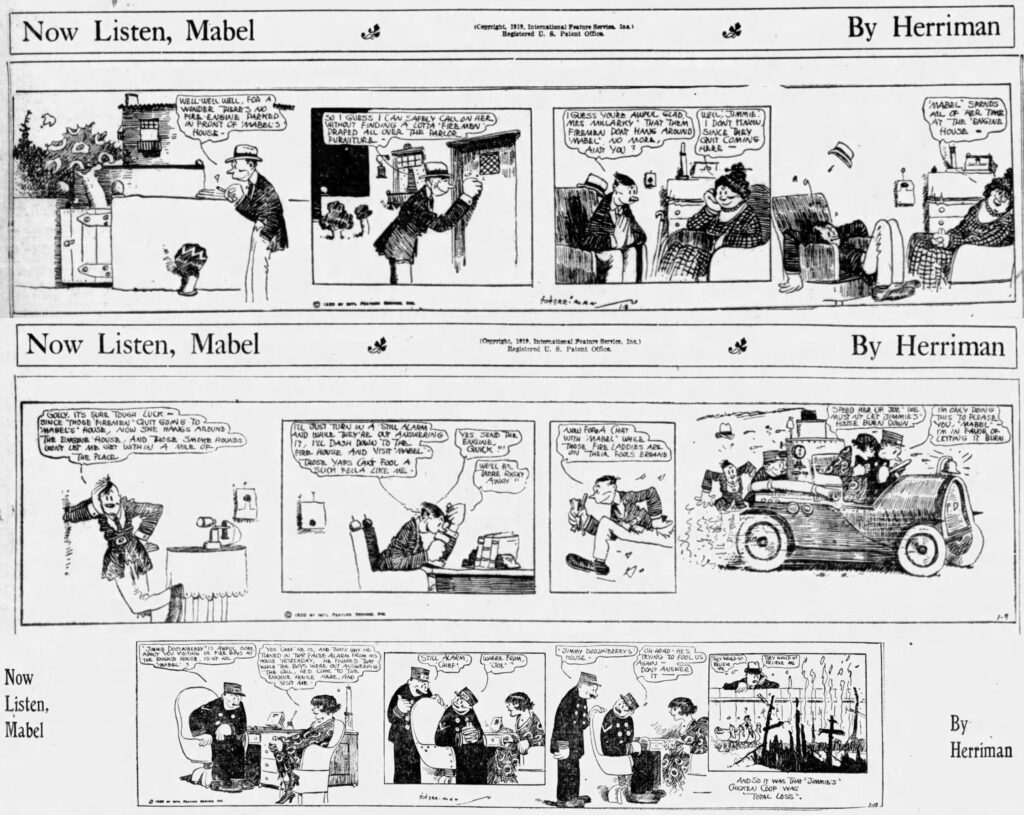
Here, as an early Christmas present, are the remaining “Now Listen Mabel” strips by George Herriman from 19191222 to 19200110. The parallels with “Krazy Kat” are even more prominent here, as Jimmie Doozinberry pursues the lovely Mabel, as hopeless a lover as Offissa Pupp with Krazy Kat. Jimmie has to constantly compete with large groups of men in these strips, such as the Police and Fire departments. Mabel just doesn’t feel comfortable with Jimmie by himself, she feels safer, and more romantic, in a crowd of guys. I wonder if “Now Listen Mabel” continued beyond 19200110 in any other papers? Allan Holtz gives the final publication date as 19191218, so now that goes down as another mistake in Allan’s wonderful “American Newspaper Comics” reference book. I can’t help but be curious about Garge’s wife, Mabel herself. Did her husband base any of the comic strip character Mabel on his wife or his daughter (both named Mabel)? Were they as big mercurial flirts and two-timers as they appear in the comics? I guess we’ll never know. So this is “so long” to the “complete” reprint of “Now Listen Mabel”, which I started back in 2021 in a post called “An End and A Beginning”. The date was 20210227. My Krazy Kat reprints stopped then, and also my blog was hacked again around that time. I hope you have enjoyed the Mabels. If any of you readers and great “strippers” find any of the early “Now Listen Mabels” that the San Francisco Examiner didn’t use, from 19190423 to 19190728, please let me know! I would love to post the missing three months. If you want to see them larger, just right-click them and open them in a new window, then enlarge them to your heart’s content. If I can’t do another post soon, then Happy Christmas to all! from Mark Kausler.
Mabel Doesn’t Care

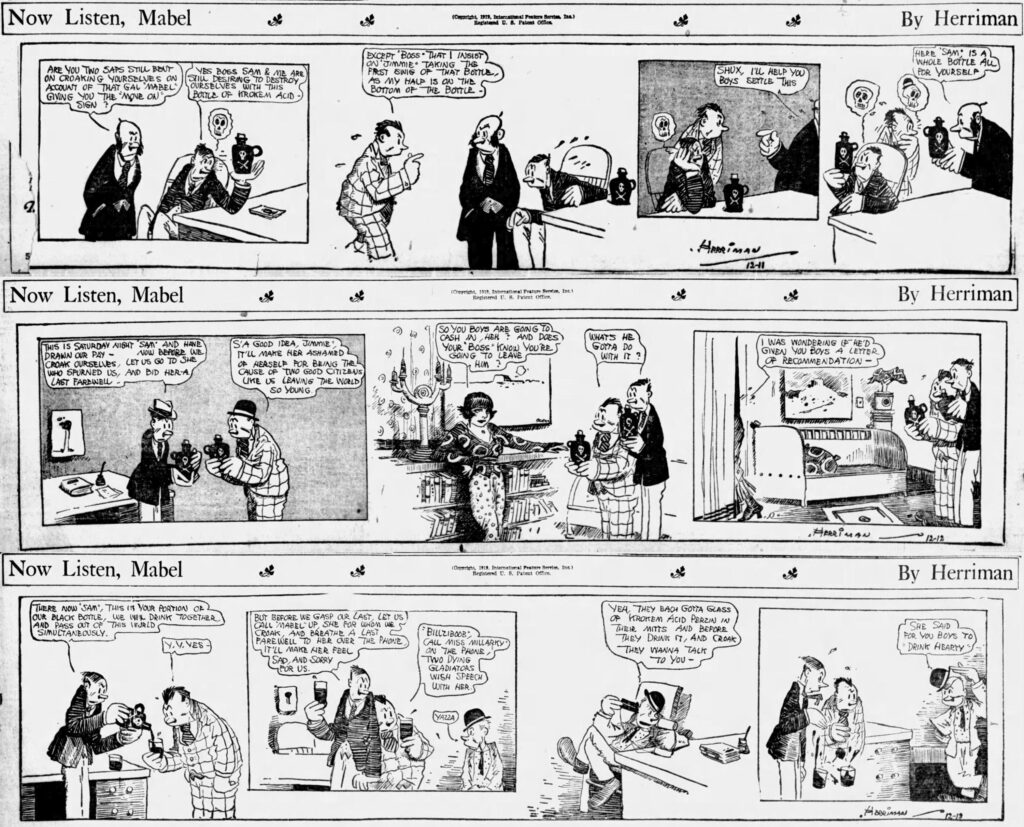
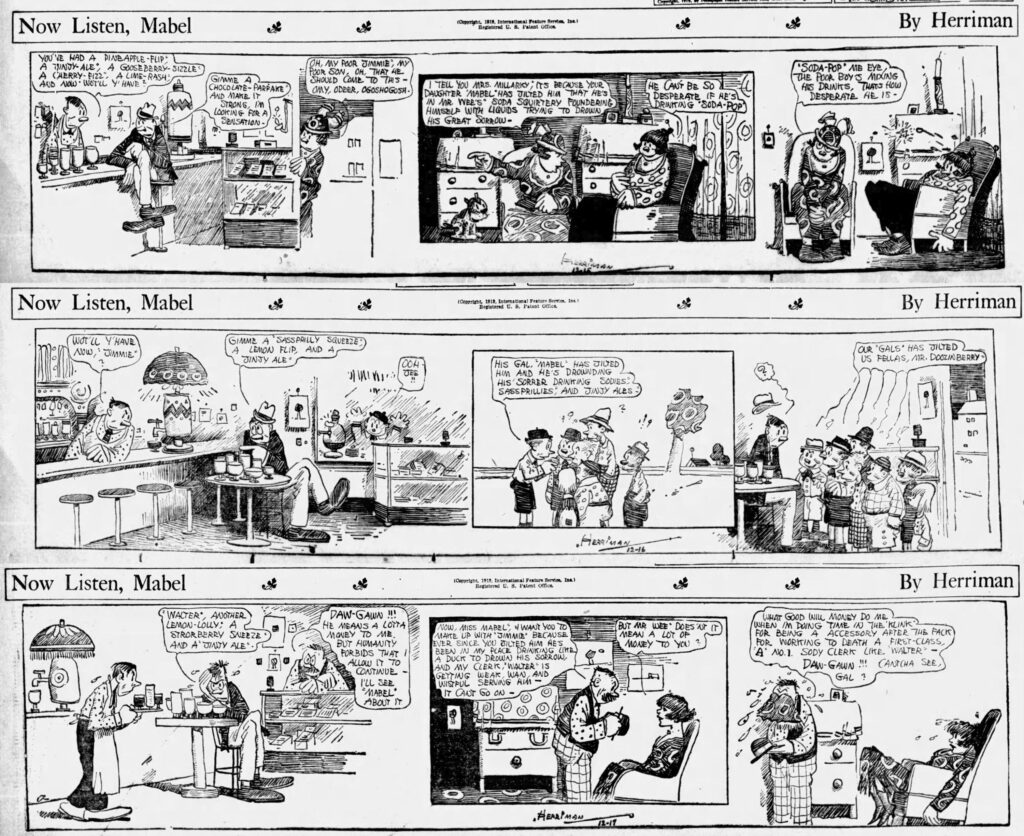
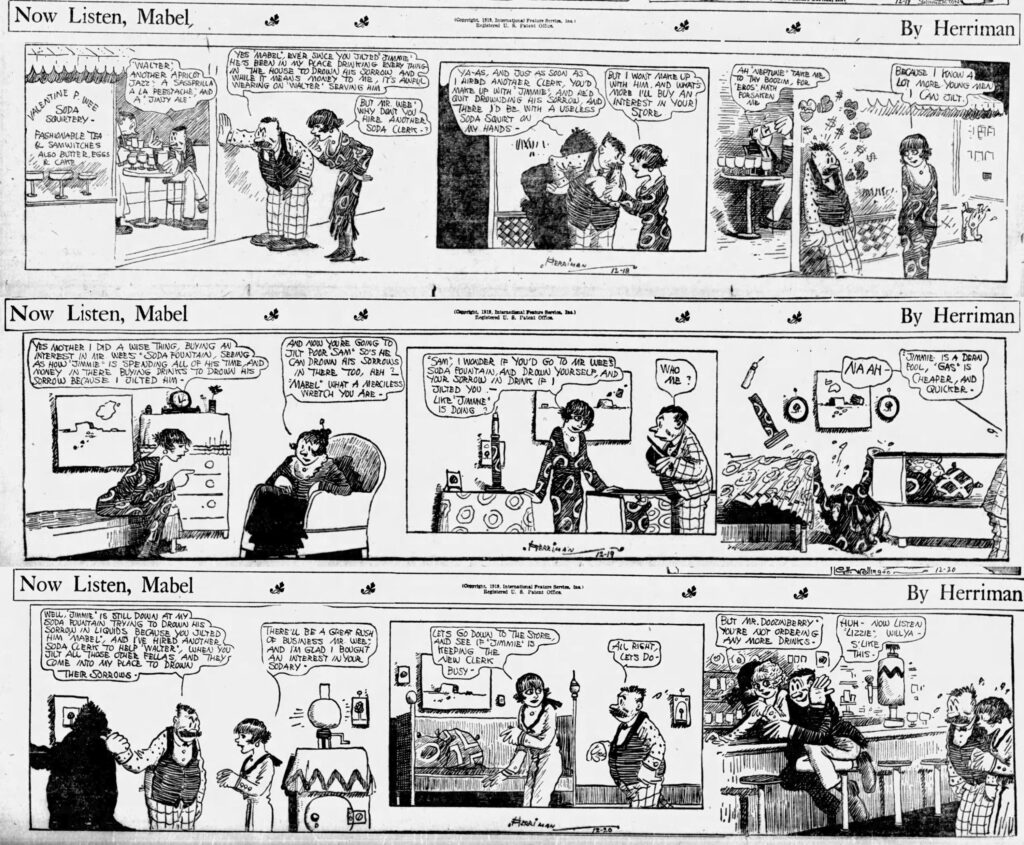
Mabel is from 19191208 to 19191220. If you can find my former comment on this post’s strips, please look them up. My blog was hacked and this post disappeared. Good Hunting!
Felix Vs. A Spy From Brigandia
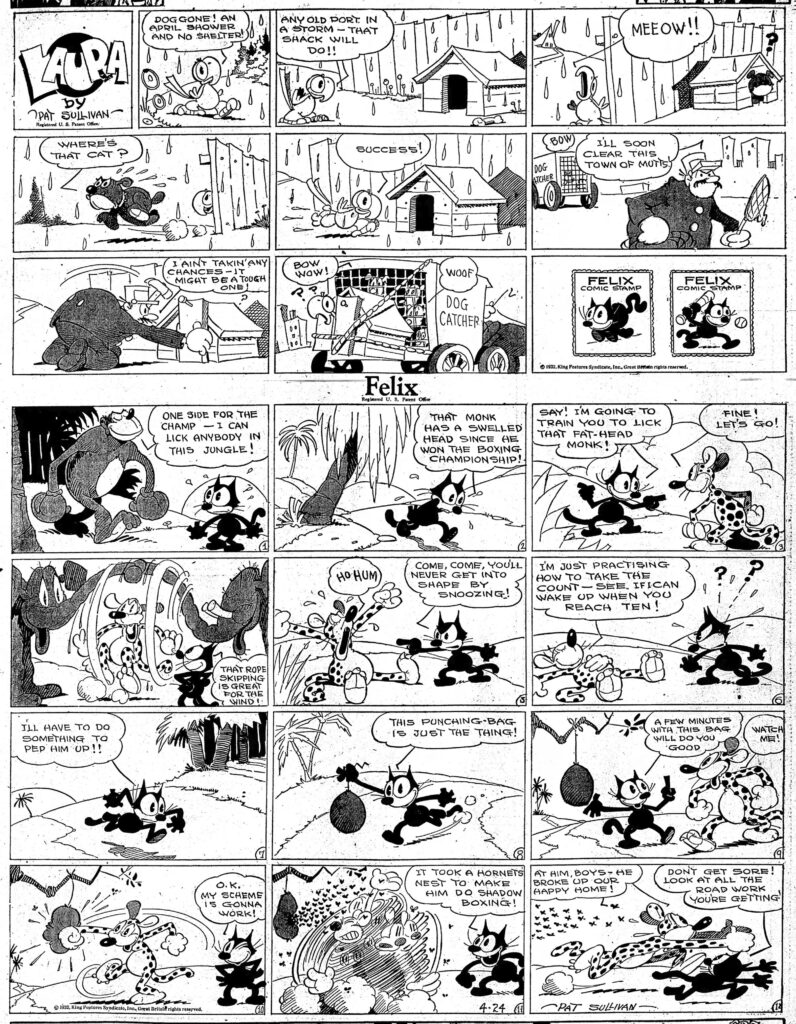
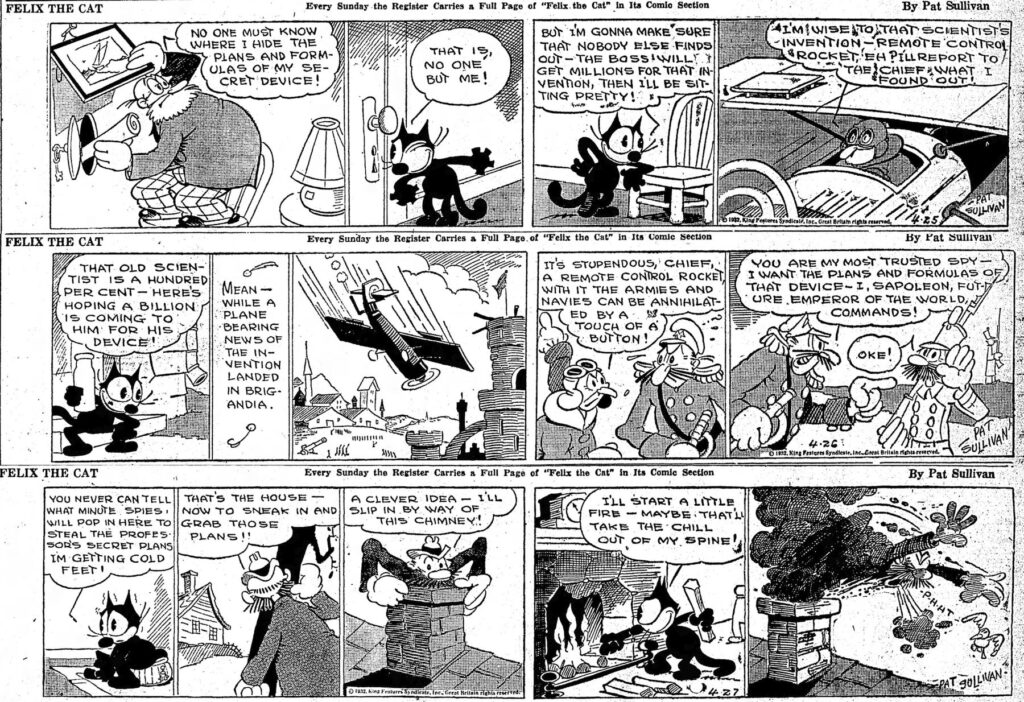
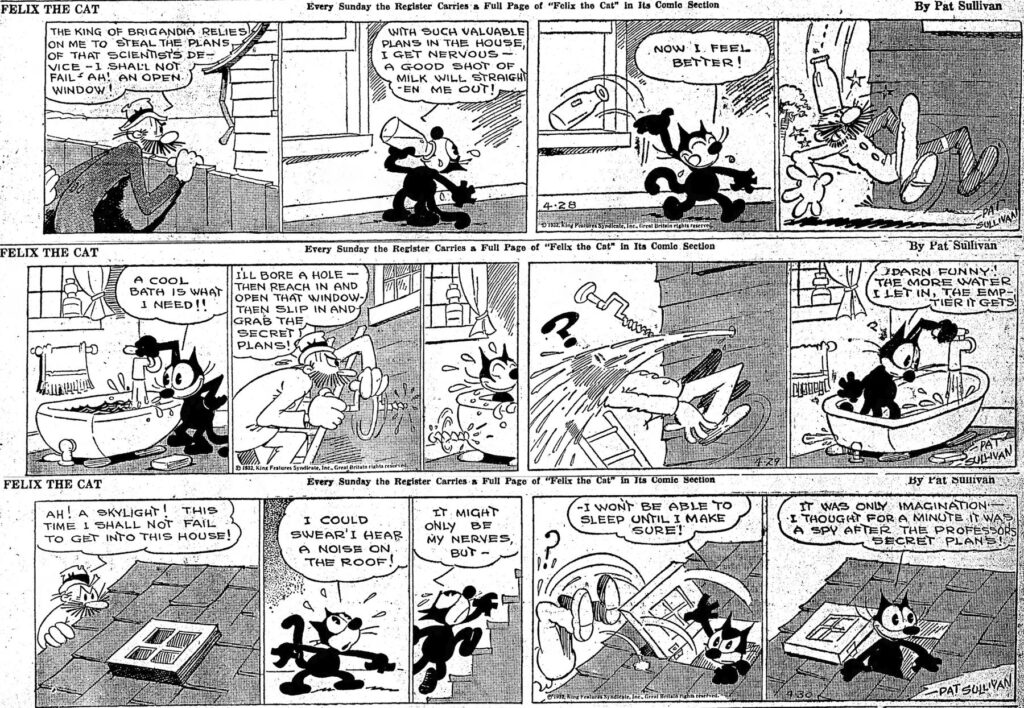

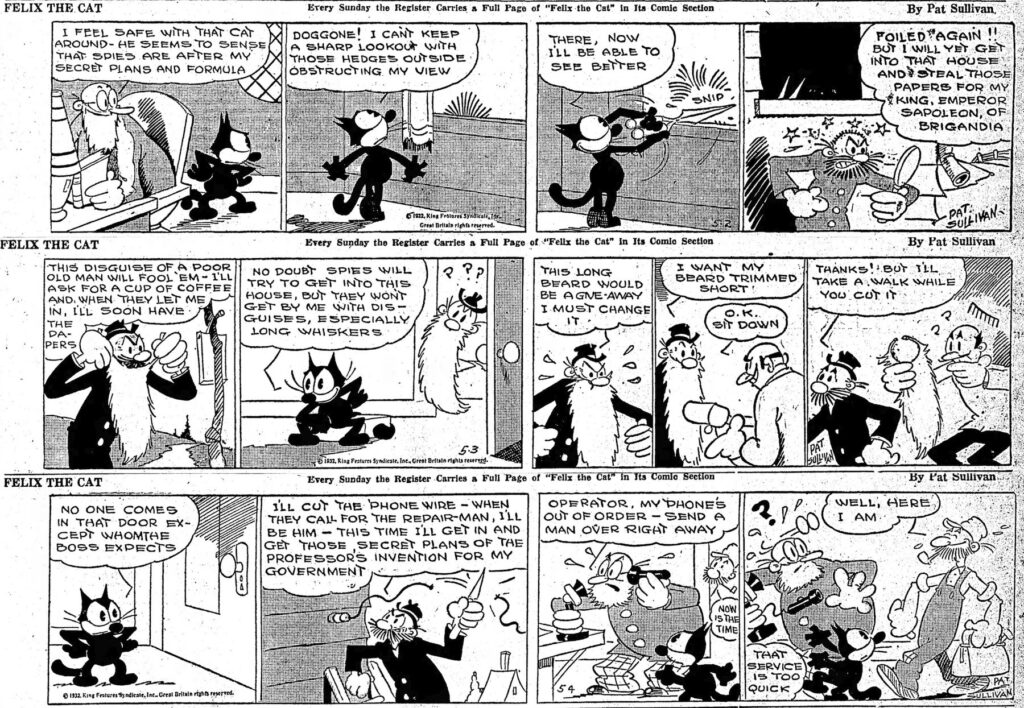
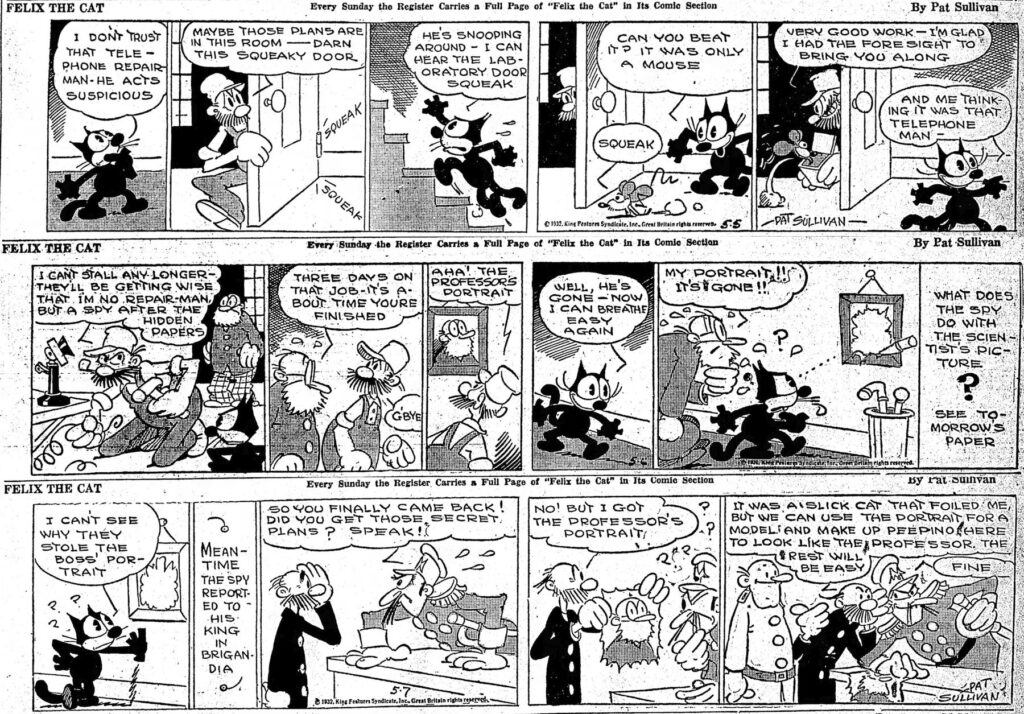
In these Felix strips from 4-24 to 5-7-32, Felix returns from the Moon, only to encounter a spy from the kingdom of Brigandia, who wants to steal all the professor’s secrets. Due to the recent attack on my blog, this post had to be rescued and done over. I hope you will enjoy reading it.
Felix On the Moon
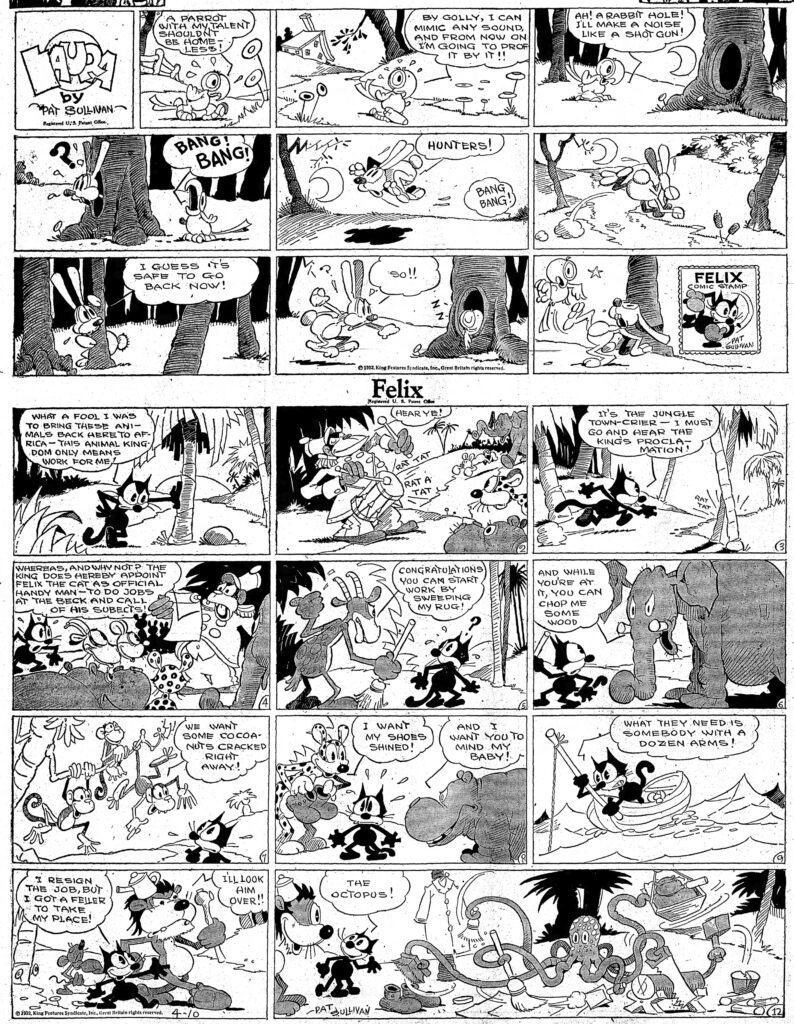
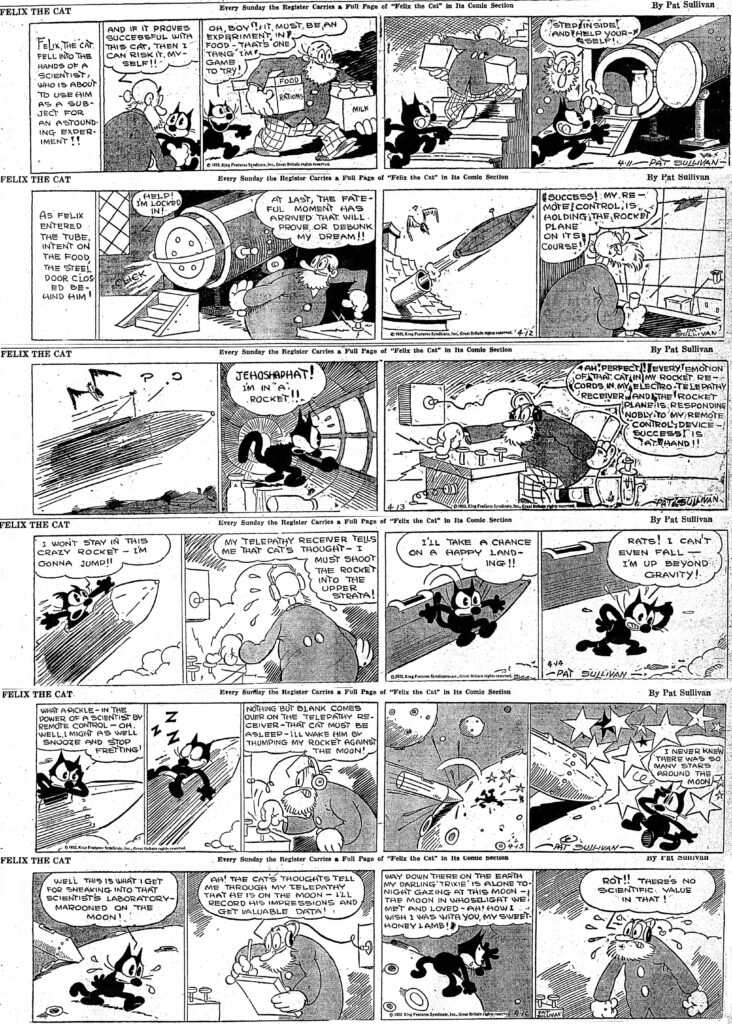
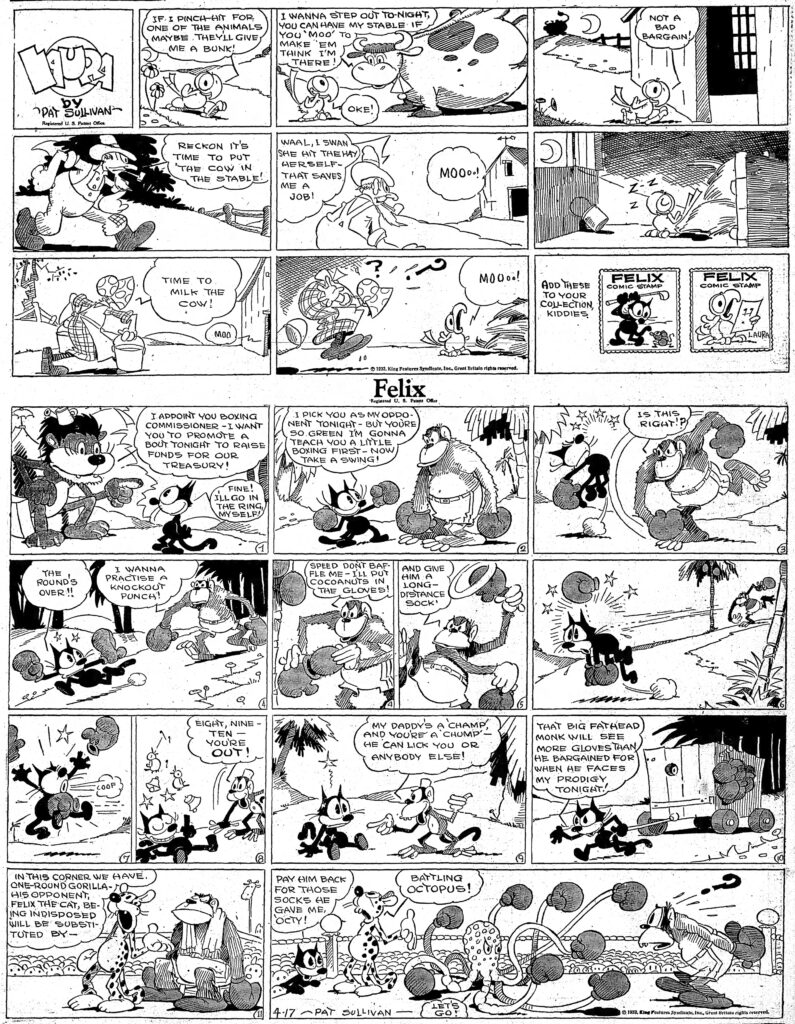
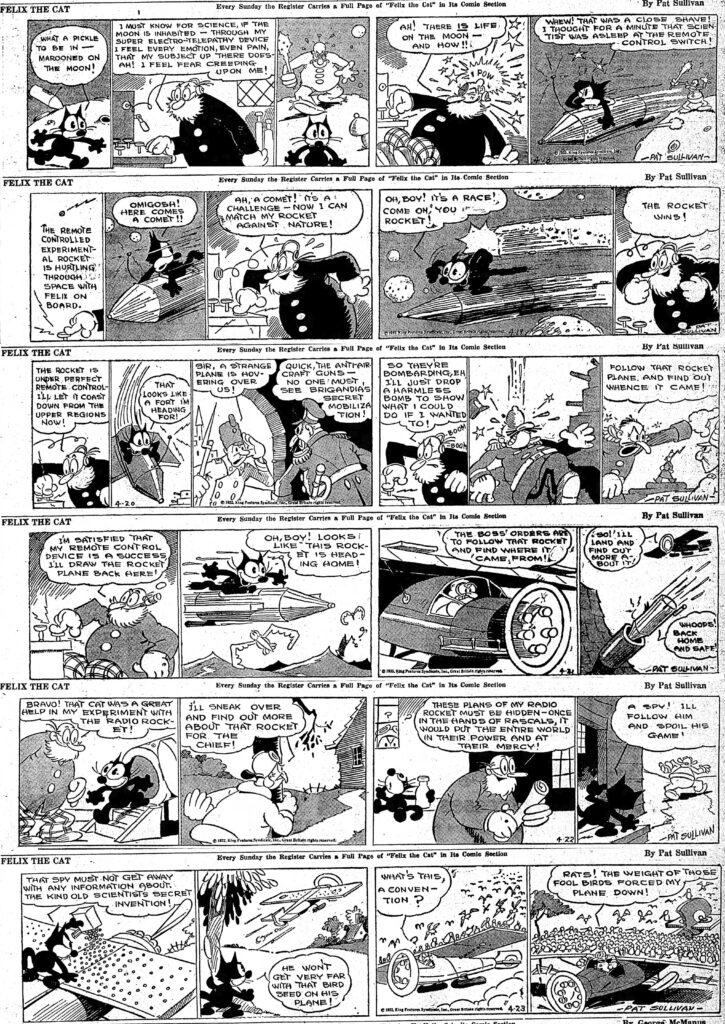
The Catblog presents Felix from 4-10 to 4-23-1932. Felix meets a kindly old scientist in the 4-11, who tricks Felix aboard his one-cat rocket to the Moon! Felix spends his time on the Moon pining for his girlfriend Trixie, much to the scientist’s disgust. Felix wins a race with comets and foils a spy’s attempt to steal the Old Scientist’s secret rocket invention in the 4-23. In the Sundays, Felix uses an Octopus he caught undersea to feed his animal friends and win a boxing match against one-round Gorilla! Make sure you clip and save the Felix Comic Stamps for your album! See you soon, Mark and Itza
Mabel’s Cops
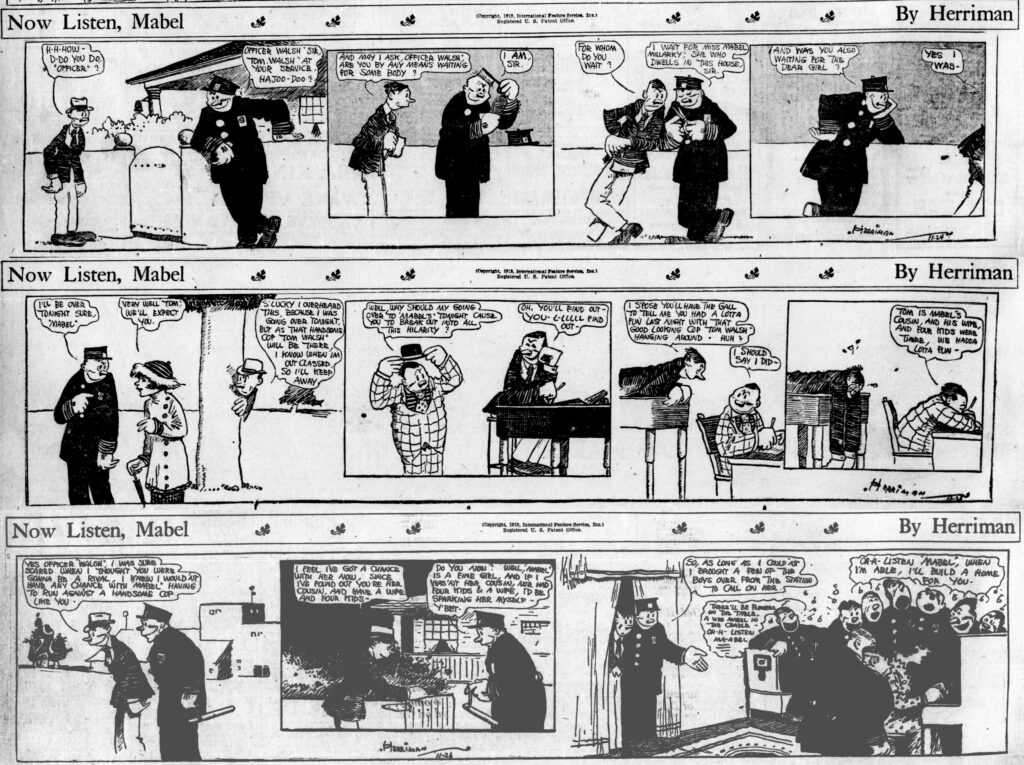
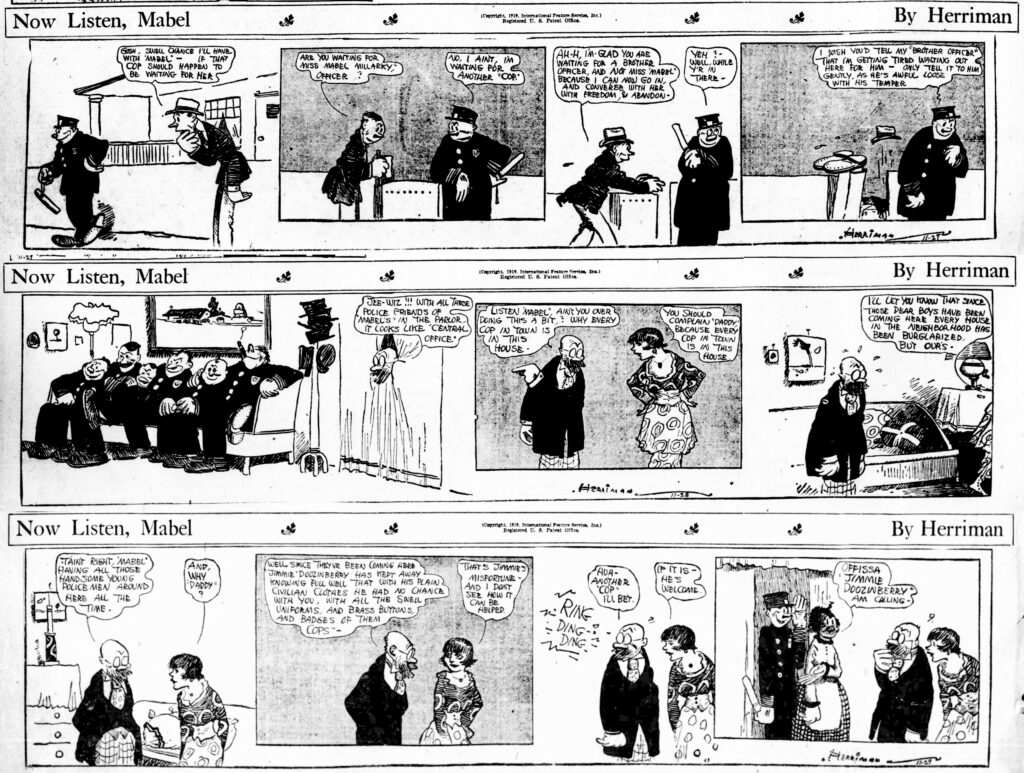
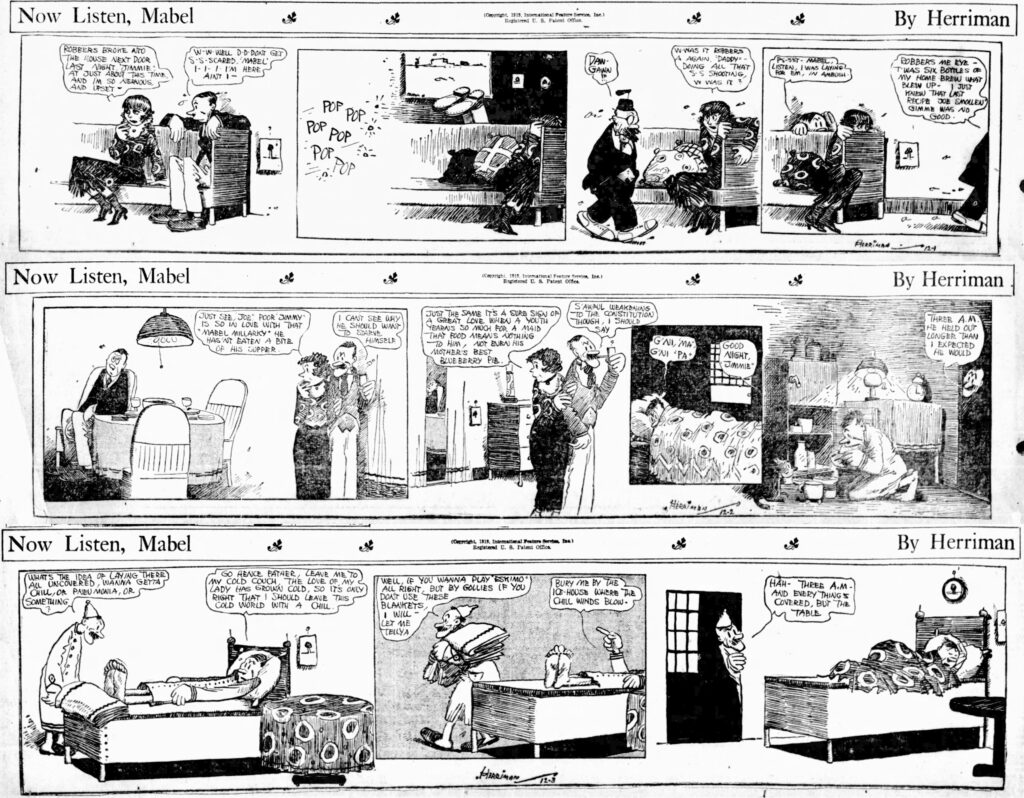
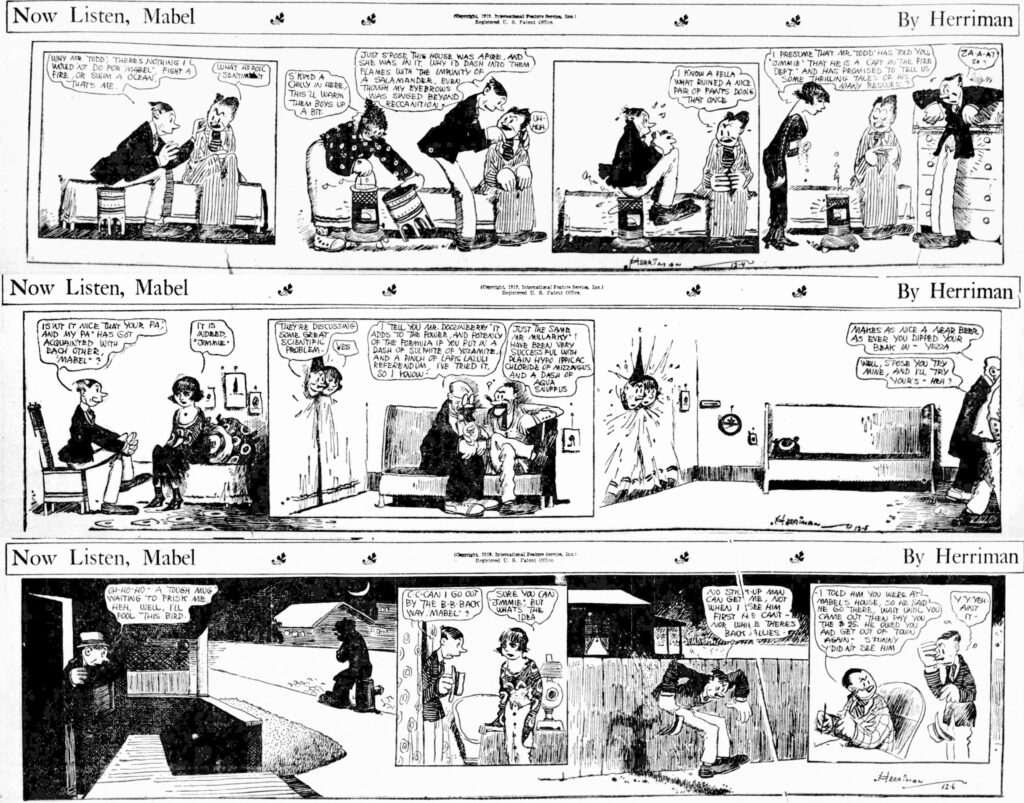
This time out the “Now Listen, Mabel” strips are from 11-24 to 12-6-1919. Jimmie Doozinberry is jealous of Policeman Tom Walsh who turns out to be Mabel’s cousin and is married. The boys from the Police station gather around the piano and sing “Ohh, Listen Mabel” to her in the 11-26. I’m not sure if “Ohh, Listen Mabel” was an actual, or Herriman-created popular song? Do any of my readers know the answer? Jimmie solves his Police problem in the 11-29 by joining the Force! Prohibition was still a joking matter in 1919 as the two dads concoct a Near Beer formula. I like the way Garge constructs the graphics on these dailies, every other panel is a floating insert, hovering over the backgrounds. Mabel and Krazy Kat both seem indifferent to their suitors at times–Jimmie Doozinberry, like Offisa Pupp, is in love with a creature who seems constantly infatuated with somebody else–Garge is using some of his Triangular Titillation in his non-Kat strips. Remember to display the strips in a new window, so that you can enlarge them for easier reading. Thanks, Mark and Itza
Felix Gets a Tail Implant
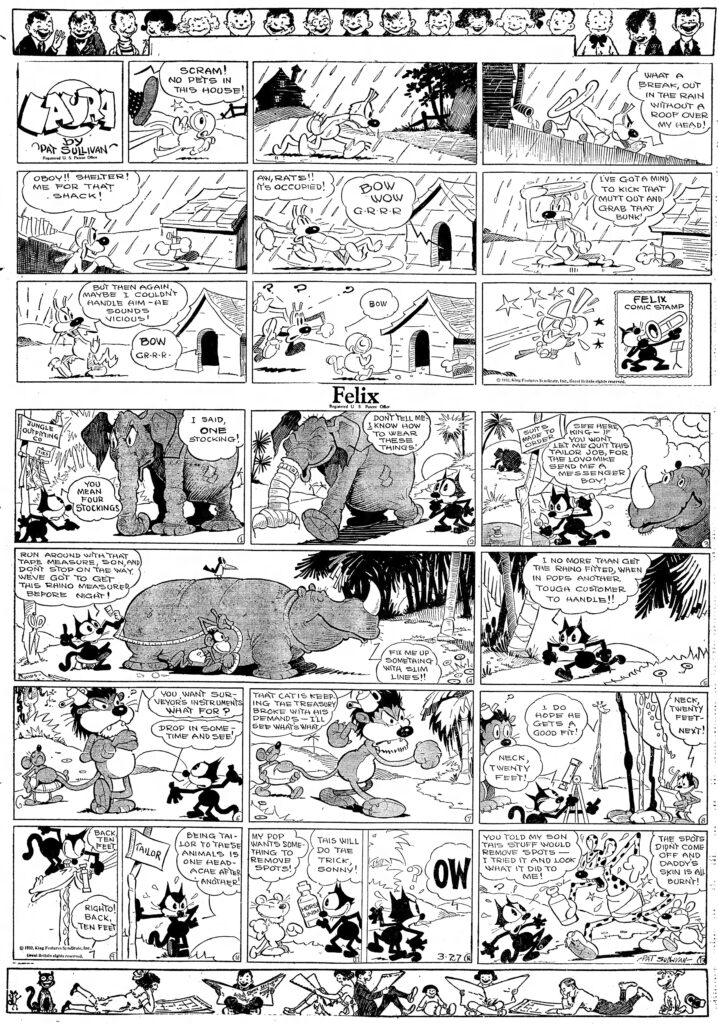
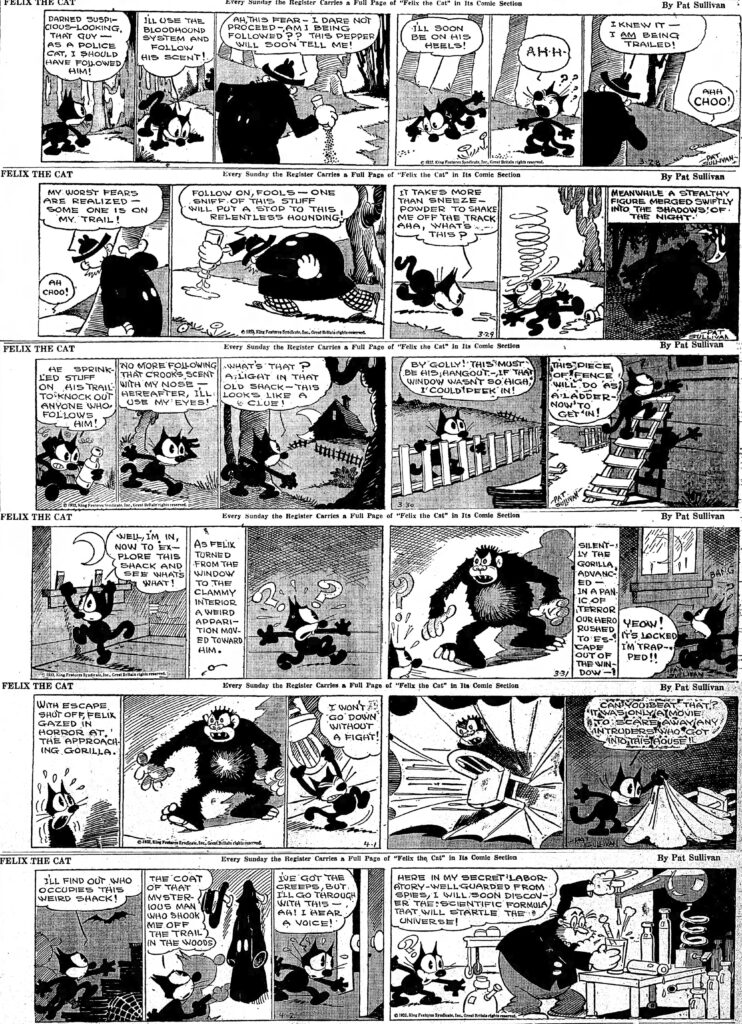
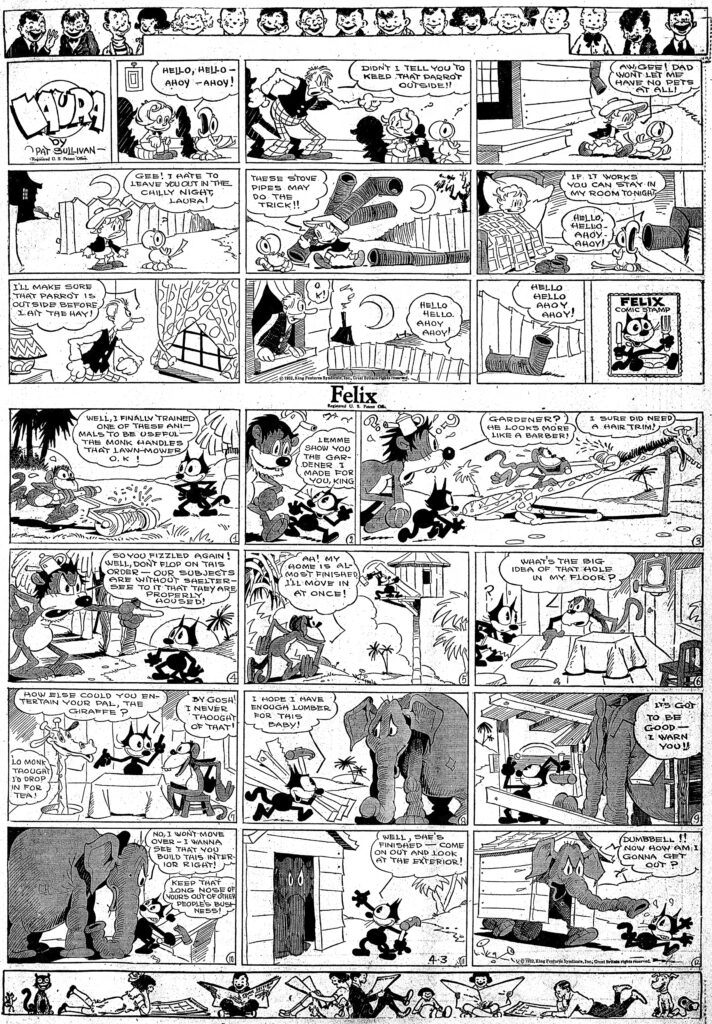
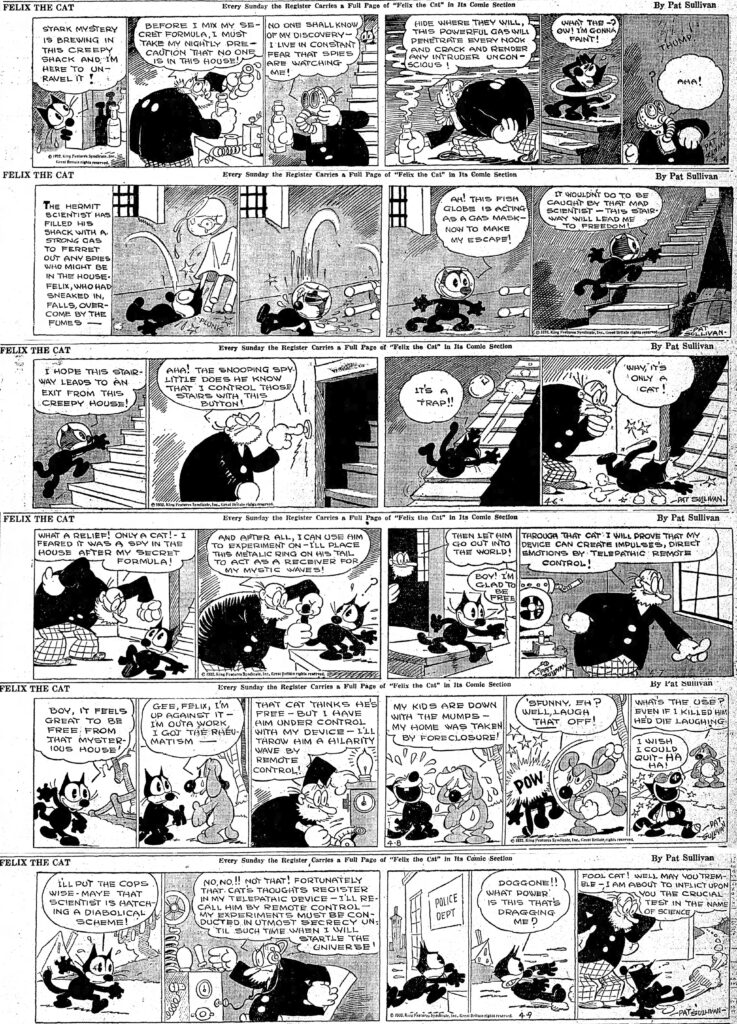
Here’s our Felix from 3-27 to 4-9-1932. Felix’s Police Cat adventures continue in the dailies as Felix trails a mysterious scientist to his weird old house in the country. The little black cat is almost fooled in to thinking that a movie of a gorilla is the real thing, then succumbs to gas. The scientist places a metallic ring on Felix’s tail which acts as a receptor for the “Mystic Waves”, which influence the cat’s emotions and enable the scientist to magnetically control Felix’s body. In July of 1932, the comedian Charley Chase made a two-reel comedy called “Now We’ll Tell One”, about a scientist who invents a belt that can transmit a person’s personality to another one wearing the same kind of belt, ten miles away. In 1934, Chase made a second two-reeler, “Another Wild Idea” featuring a scientist who invented a ray gun that had the power to transform any person into one without inhibition. So Charley Chase picked up on an idea from the Felix strip, and formulated two film comedies out of it. This idea of the tail implant, and the impact it had on Felix’s personality, was used a few times in the Felix comic books of the 40s through the 1960s. I think, though, that this was the earliest appearance of the basic idea of mechanical alteration of the personality in the Felix comic strip. Today, the descendants of Otto Messmer might be tempted to plant A.I. in Felix’s body, and use it for the same type of gags. The Sunday pages continue Felix’s adventures with the Noah’s Ark animals on a tropical island. Enjoy these, the best drawn and designed Felix strips of the Golden Age! Mark
Felix Goes Camping
July 7, 2024
Cathy Hill's Comic Art, Comic Strips, Felix the Cat
2 Comments
Mark
Hi Folks, Our special header this time is by my favorite cartoonist and artist, Cathy Hill, inspired by Otto Messmer’s art, called “Felix On The Rocking Horse”. I love the Felix rug on the floor and the little duck following the rocking horse, ably rendered in Prismacolor pencils. Thanks, Cathy! The Felix strips this time are from 19320814 to 19320827. In the dailies, Felix goes camping with the selfish wealthy man and his wife, but has a miserable time of it. Felix grows tired of being kicked and starved, so he goes home to the wealthy family’s town house in the city, and takes up residence while the couple are still roughing it. I love the 8-25 with the owl being gagged, and the giant prehistoric fish skeleton in the 8-23. Look at the beautiful stippling effect Otto tried in the 11th and 12th panels of the 8-14 Sunday as the dogs bust a vacuum cleaner bag, thinking it’s a sausage. In the 8-21 Sunday, in panel 5, Felix gets konked with a rock, not unlike Garge Herriman’s Krazy Kat! I hope you enjoy little Felix’s 1932 adventures and keep watching for the next batch! Comically, Mark